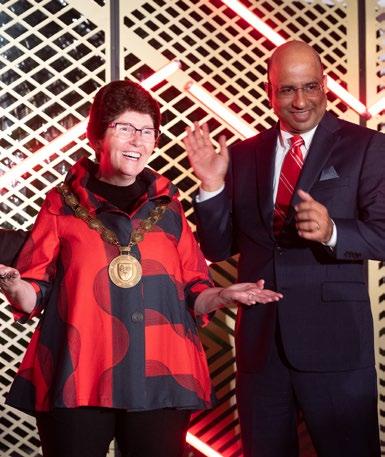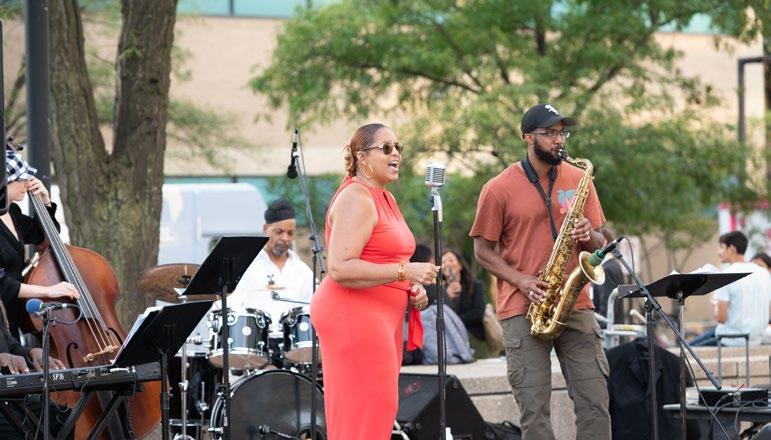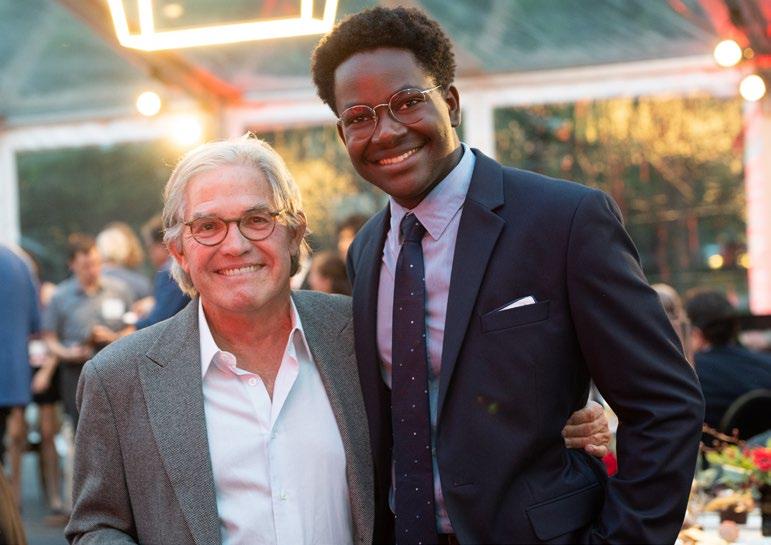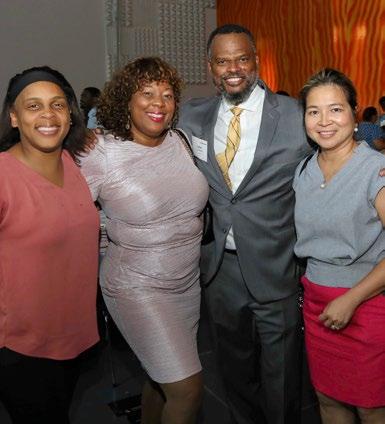A Different Drum
John Katsoudas (M.S. PHYS ’03) had to choose between music and physics. The end result is a battery design that plays to a different beat.
Answering the “EJ” Call Solving the Sonic Boom
Impacting Chicago’s Landscape


John Katsoudas (M.S. PHYS ’03) had to choose between music and physics. The end result is a battery design that plays to a different beat.
Answering the “EJ” Call Solving the Sonic Boom
Impacting Chicago’s Landscape

When I first arrived at Illinois Institute of Technology, I was thrilled to take my place in a growing, innovative community with such incredible potential. Now, after nearly two years serving as president, I can honestly say that the opportunities and innovations I’ve seen flourish on campus have far exceeded my expectations.

I’ve repeatedly pointed to our university’s founding mission—and it’s worth doing so again. We are here to offer every learner—no matter their background—the chance to contribute to advances in science and technology that will allow them to thrive in their fields. As I sit at my desk in the heart of Bronzeville, our home for more than 130 years, I am again reminded of the
power of our collective differences, and I have already witnessed those differences contributing to incredible achievements.
Such achievements need both opportunity and support—two things that Illinois Tech now provides like never before.
We’ve bolstered our online offerings, using strategic partnerships with companies such as Outlier to provide opportunities for learners all around the world to access our comprehensive, tech-focused curriculums.
Together with DMG MORI, we will establish a national center for advanced manufacturing—one of the nation’s first joint university and industry academies to train, develop, and empower the advanced manufacturing workforces of the
future. We have joined the Midwest Semiconductor Network, allowing for exciting research and vocational opportunities as we help build our country’s semiconductor and microelectronics industry. And we recently received a federal grant to create the Bronzeville Opportunity Engine on campus, which will deepen our relationship with the South Side neighborhood that we are proudly a part of, providing skills training and small-business support for the thousands who live here.
I know we could not have achieved any of this without the strong support of our alumni. As I look at some of those highlighted in this issue, I am reminded that Illinois Tech has always had, at its core, a community of leaders and innovators who do not choose a common path—and I am once again appreciative of the power of our collective differences.
Take the timely topic of clean energy: Influit Energy, a company co-founded by John Katsoudas (M.S. PHYS ’03), is working to create the world’s first rechargeable, safe liquid-electric fuel. In health care, Michael Plesniak (ME ’83, M.S. ’84) has applied his deep knowledge of fluid dynamics to the complexities of the human body, with impressive results.
In the public sector, Cynthia M. Ferguson (LAW ’00) has dedicated her career to improving the environment for everyone, regardless of their background or circumstance, and she was recently appointed by the White House as the United States Department of Justice’s first environmental justice officer.
Illinois Tech will continue to position its students and alumni on the cutting edge of the forthcoming Fourth Industrial Revolution, an era that will be marked by technological transformation and the ability to see where those advances might lead.
Thank you for your continued support, and I look forward to our future achievements together.
Sincerely,
Raj Echambadi PresidentVice President for Enrollment Management and Student Affairs
Mallik Sundharam
Associate Vice President for Marketing and Communications
Chelsea Kalberloh Jackson
Content Director
Andrew Wyder
Managing Editor
Tad Vezner
Editorial Contributors
Howard J. Lee
Thaddeus Mast
Casey Moffitt
Kayla Molander
Simon Morrow
Art Direction
Scott Benbrook
Design Scott Benbrook
Photography
Edgar Artiga
William Atkins
Jamie Ceaser
Tim Klein
Michael Reiter
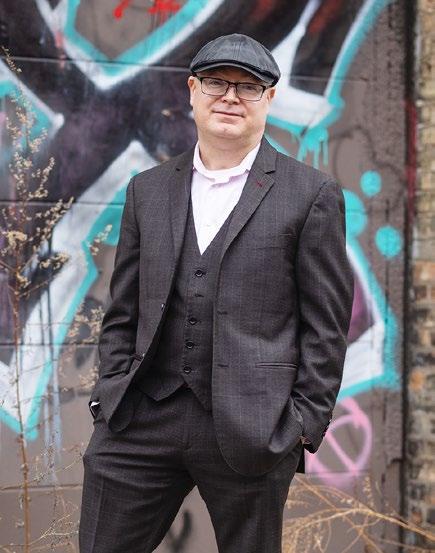
Garry Tice
Web Edition
Brian Bailey
Peter Beltemacchi
Abbey Vargas
Illinois Tech Magazine is published twice a year by the Office of Marketing and Communications. © 2023 Illinois Tech Magazine is printed on FSC-certified recycled paper. Read it, share it, recycle it.
Send Letters to Illinois Tech Magazine
Office of Marketing and Communications
10 West 35th Street, 13th Floor Chicago, IL 60616
or email illinoistechmagazine@iit.edu
Send alumni news to alumni@iit.edu
Illinois Institute of Technology, also known as Illinois Tech, is a private, technology-focused research university. Based in the global metropolis of Chicago, Illinois Tech is the only university of its kind in the city. It offers undergraduate and graduate degrees in engineering, science, architecture, business, design, human sciences, applied technology, and law.
One of 22 institutions that comprise the Association of Independent Technological Universities (AITU), Illinois Tech provides an exceptional education centered on active learning, and its graduates lead the state and much of the nation in economic prosperity. At Illinois Tech students are empowered to discover, create, and solve, and thus uniquely prepared to succeed in professions that require technological sophistication, an innovative mindset, and an entrepreneurial spirit.
Mission Statement
To provide distinctive and relevant education in an environment of scientific, technological, and professional knowledge creation and innovation

Armour College of Engineering
Chicago-Kent College of Law

College of Architecture
College of Computing
Institute of Design
Lewis College of Science and Letters
Stuart School of Business
ADA Statement
Illinois Institute of Technology provides qualified individuals with disabilities reasonable accommodations to participate in university activities, programs, and services. Such individuals with disabilities requiring an accommodation should call the activity, program, or service director. For further information about Illinois Tech’s resources, contact the Illinois Tech Center for Disability Resources at disabilities@iit.edu.
7
COVER STORY
John Katsoudas (M.S. PHYS ’03) went from being a gearhead growing up on Chicago’s South Side to co-founding a company that’s developing what could be the next big thing in the electric battery market.

10
When Cynthia Ferguson (LAW ’00) became the United States Department of Justice’s top environmental justice official, she didn’t tell a soul. Now the story’s out, and her colleagues say they aren’t surprised.

14
A lifelong aviation aficionado, Michael Buonanno (AE ’01) has his sights set on addressing an issue in flight that has been stagnant since the 1960s: building planes that go faster but aren’t affected by the sonic boom.
16
If you’ve driven, biked, or even walked in Chicago, you’ve seen the influence of Kris Sorich (M.A.S. LAND ’14). As the Chicago Department of Transportation’s lone landscape architect, she’s offered input on even the tiniest street projects.
12
Michael Plesniak (ME ’83, M.S. ’84) became an expert in fluid dynamics. Then he started looking at the complex machine known as the human body.
The following are excerpts from a handwritten letter from reader Ronald A. Dickman (BE ’67), who supplied many comments about the fall-winter 2022 issue of Illinois Tech Magazine. Here is a selection of some of Dickman’s commentary on this issue.
• “ The letter from Charles Ticho (EE ’48) brought back many memories. I remember reading Metamorphosis in Old Main and also taking various accounting courses. Yes, the gist of Metamorphosis has been with me all my life!”
• “Alzira Maldonado Protsishin is a great example of the new president’s wish—‘an engine of opportunity for students from all backgrounds,’” about the article on Maldonado Protsishin (M.A.S. ARCH ’14)
• “Great article! Again, a great example of education for all,” regarding the Llewellyn “Don” Means Jr. (EE ’89) feature
• “A new era!” remarking on the article “Cracking the Code on Health Care” about Saurabha Bhatnagar (CS ’02)
• “My grandfather, an old German tool and die guy, was making ‘Halli-kits’ for Hallicrafters. People were not putting rubber grommets in various holes and a ‘hot’ chassis resulted. My gramp put a grommet right into the chassis, thus a ‘hot’ chassis was avoided,” about the article “Education Engineers Success” on Ralph L. Barnett (CE ’55, M.S. MAE ’58, Ph.D. CE ’21)
Illinois Institute of Technology College of Architecture students are partnering with a Chicago developer and alderman to build homes in the city’s Englewood neighborhood for what is called a “missing” demographic in the home-building world: middle-class families.
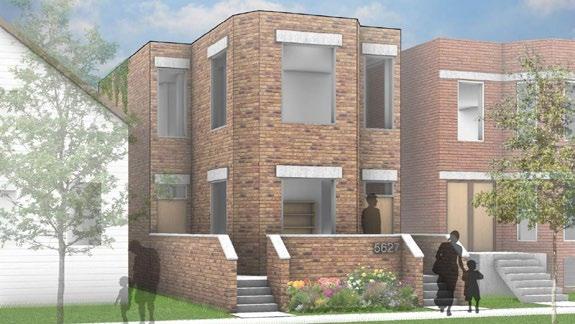
The plan took shape when project client and Englewoodraised Kenny Smith, CEO of the nonprofit Wholistic Community Development Association, walked into S. R. Crown Hall last year and asked for help designing homes for a new project to reinvigorate the neighborhood.
The project grew to include Chicago Alderman Stephanie Coleman (16th Ward), whose district includes her home community of Englewood, and a dozen students in a fifth-year studio led by Adjunct Professor Steven Pantazis.
“It’s not that folks don’t make enough to live in nice housing,” Coleman says. “The stock just isn’t there. The same
people want to live in clean, modern, and efficient homes.”
For students, the project is deceptively straightforward: to design a home that the “missing middle” can afford, Pantazis says. “Speculative developers are building affordable housing for socioeconomically challenged buyers, or they aim for high-end luxury. No one is targeting middle-income people. A lot are moving to the suburbs because housing isn’t available.”
Houses or classic Chicago two-flats are slated to be built on more than 20 empty lots southwest of the intersection of South Halsted and West 63rd streets.
The first home built as part of the project will be based on a student design, which is an opportunity rarely afforded to students—seeing their schematics become reality.
“The studio is somewhat unique for an architecture school,” Pantazis says. “It’s an opportunity for students to work with a real client with the potential of seeing their designs built.” —Thaddeus Mast

Illinois Institute of Technology has ramped up its efforts to engage local high school and middle school students in STEM learning, with a little playful experimentation on the side.
In February 2023 AeroStar Avion Institute, a Chicagobased nonprofit that serves as an educational pipeline for underrepresented groups, teamed up with Illinois Tech for an event titled Engineering HER Future in Space, in which 40 middle school and high school students engaged in individual and team activities such as drawing planetary orbits and learning how to use design thinking to draft a rocket.
The keynote speaker, Mae Williams (CE ’99) of CKL Engineers Ltd., spoke of the importance of persistence and in securing mentors who don’t necessarily look like you. Williams said she struggled during the start of her academic career, posting a 1.5 grade-point average in her first year, but graduated with a 3.0 GPA and now runs her own company.
Tammera Holmes, AeroStar’s founder and CEO, grew up in the Chicago suburbs, “fell in love with aviation” at the age of 16, and was one of only two African-American women in Southern Illinois University’s aviation program.
“It’s an honor to partner with higher-education institutions that understand that early access is the key to long-term success when it comes to STEM,” Holmes says of working with Illinois Tech, with whom she has been partnering for its AeroSTEM expos since 2017.

In October 2022 AeroStar sponsored another aviation and aerospace event in which 64 students arrived on campus to learn about the fields. Faculty members from Armour College of Engineering’s Department of Mechanical, Materials, and Aerospace Engineering supplied materials and assisted in instruction. —Tad
Veznerit was one of five finalist teams judged by a panel of Chicago technology experts. The team included André Guardia, (PHYS 4th Year), Jorge Plascencia (AE 2nd Year), Rishabh Tyagi (CS 4th Year), and David Singer (ITM 4th Year).
The second annual Grainger Computing Innovation Prize was awarded to a team of Illinois Institute of Technology students for its invention of a cross-compatible, simple-to-use stablecoin payment solution that would address the financial

access gap for millions of Mexico’s unbanked.
The winning team, Baro—named StarPay during the competition—was awarded the $15,000 first-place prize during a live event held in November 2022, in which
With Mexico’s government aiming to launch its own Centralized Digital Bank Currency (CryptoPeso) by 2025, the team said it hoped its invention will become “the go-to payment solution for the future of the country’s CDBC infrastructure.”
“With 90 percent of all transactions [in Mexico] being in cash, fragmented smart phone capabilities, and inconsistent internet coverage, there is a great need for a simple, cross-compatible payment network,”
says Guardia, the Baro team leader. “Financial access in Latin America is profoundly important to us, as we’ve experienced firsthand the cascading consequences of being outside the traditional financial system: theft, corruption, predatory rates, and exclusion from digital services.”
The annual Grainger Computing Innovation Prize aims to solve critical societal challenges through innovative computing solutions and cross-disciplinary collaborations. The Grainger Foundation, established in 1949 by William W. Grainger, founder of W.W. Grainger, Inc., is an independent, private foundation based in Lake Forest, Illinois.
—Petra Kellythese large language models, of which GPT is an example, beginning to make increasing progress at least with general language, and we thought maybe this will be the one that can cross the


A team of Illinois Institute of Technology students took the top prize in the 2022 Keysight Innovation Challenge for its novel “Tree of Life” Internet-of-Things device, which collects data from the soil and the atmosphere around it to determine the best trees to plant for maximum carbon dioxide capture and optimum growing conditions.

The Illinois Tech team came in first out of an international group of 52 teams after giving its final presentation on October 29, 2022.
The team’s impressive design won the students $30,000 in cash, as well as $10,000 worth of Keysight test equipment for Illinois Tech.
The team includes Chloe Rubinowicz (EE, M.S. EE 5th Year), Saurabh Saluja (CPE, M.S. CPE 5th Year), Colin Prochnow (CCSE, M.S. CPE 5th Year), Kaya Jones (CS 2nd Year), Anthony Banuelos (CCSE, M.A.S. CYF 5th Year), and Katarzyna Staron (ME, M.S. ME 5th Year).
The team says the “Tree of Life” was designed as a response to the urgent need for solutions to curb carbon emissions. Soil and forests are the two most essential carbon sinks on Earth, and the “Tree of Life” is designed to maintain and protect both.
The device is planted into the ground, where it collects information about the soil nutrients, measures local carbon dioxide levels, and uses a neural network to identify surrounding trees or other obstructions. The team designed an algorithm that then evaluates this data using a database of more than 2,000 trees and recommends the optimum tree to plant in that location.
The 2022 Keysight Innovation Challenge asked students to create an IoT innovation that provides carbon neutrality corporate site monitoring, multi-site monitoring, or community monitoring. The device had to communicate wirelessly, be easy to deploy by a non-expert in a secure fashion, and be able to handle sensitive data.
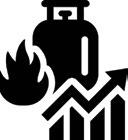 —Simon Morrow
—Simon Morrow
“I believe we need to look into a more holistic solution, rather than all natural gas or all electric. We need to come up with an option that considers all those alternatives: natural gas, electricity, even hydrogen for heating homes.”
—Mohammad Shahidehpour, Carl and Paul Bodine Endowed Chair in Electrical and Computer Engineering and director of the Robert W. Galvin Center for Electricity Innovation, discussing ways to address high natural gas prices on WTTW
“Legalese is very complicated, obviously, for people, and it’s been really thorny for machines to work with.…We saw
Rubicon.”
—Daniel Katz, professor of law at Chicago-Kent College of Law, on the LawNext podcast discussing Open AI’s GPT-3.5’s surprising performance on the bar examSTUDENT SUCCESS
“What The Last of Us did for U.S. games is it showed that we could handle tremendous complexity in a narrative structure about social issues. And in an action game, a game historically made for the ‘hardcore player,’ The Last of Us starts helping us rethink what we can do in AAA games.”
—Lewis College of Science and Letters Dean Jennifer deWinter discussing current video game trends in the Los Angeles Times
Former Illinois Tech Athletics Director Joe Hakes had a dream.
He led an energetic athletics department, one that is part of a tech-focused university and is on the cutting edge of numerous emerging fields. Hakes saw opportunity in the labs and playing fields around him.
Those immersed in athletic competition were always looking for a competitive edge. Why not rigorously test for one, using all of those on-campus labs?
In short, Hakes suggested, why not use the university’s resources to search for “effective and successful systems to achieve the highest potential results, optimal nutritional and strength preparation, and safer protective equipment.”
“From data analytics to sports medicine to sports architecture to ‘smart apparel,’ there is a wide range of opportunity to build upon what has already been done or imagined, as well as what is yet to be imagined,” Hakes wrote in a 2017 vision statement.
“It was a labor of love for Joe, and he just didn’t stop with it. He recognized a sleeping giant, as he referred to it, taking advantage of Chicago and Illinois Tech being a hub of sports innovation and technology,” says Illinois Tech Senior Associate Director of Athletics Marc Colwell, who knew and worked with Hakes.
And yet, Hakes noted in his statement that at Illinois Tech “there is a lack of an independent,
centralized center for research and development of technology aspects that drive the industry forward.”
Until now. In February 2023 the university approved the formulation of the Center for Sports Innovation to “serve as a hub for research and development of a wide variety of technologically related subjects, systems, and businesses that impact the world of sports.”
Hakes passed away in January 2023, but his vision is in full swing. Fourteen core faculty members from Illinois Tech have partnered with the athletics department, and some are already partnering on projects with sports industry leaders.
“It’s a double win for us. It allows us to really leverage our unique talents in both sports and research,” says Professor of Practice Bo Rodda, one of the core faculty members.
Rodda, who is also the faculty director of the Ed Kaplan Family Institute for Innovation and Tech Entrepreneurship’s Interprofessional Projects (IPRO) Program labs track, has partnered with Wilson Sporting Goods to build better sporting gear through that program. The partnership started during the COVID-19 pandemic, when his students were tasked with envisioning automated ways for people to get fitted for golf clubs.
Now they’re identifying new product development ideas
with Wilson advisers, including “interactive or wearable technologies, health and safety products, virtual reality technology for indoor exercise or how we watch sporting events,” Rodda says.
“We’re creating creative engineers who not only play the sport but give you the equation for the arc of the shot,” he says. “That’s what I see as the secret sauce here.”
How about building better skis?
S. C. Johnson Professor of Chemical Engineering Fouad Teymour, director of the Center for Complex Systems and Dynamics at Illinois Tech, is working to finalize a research contract with Mountain Flow, a Colorado company looking to manufacture slicker skis.
“The uniqueness of this experience, working with sports companies, is very different,” Teymour says. “I’ve been in research for 35 years, and I’ve never worked on sports applications. There’s a lot of fun involved working on something that will affect the sports world.”
“For me the center is a way to bring together an interdisciplinary group of faculty to address something most people have some connection to, which is sports,” says Coleman Foundation Clinical Associate Professor of Entrepreneurship Nik Rokop, the center’s director. “Rather than talking about research in a technical way, this is an applied way.” —Tad Vezner
Illinois Institute of Technology
Professor David Williams and his team have demonstrated the first use of a novel control method in an aircraft with no tail.
While conventional aircraft rely on protruding fins to enable steering, a tailless design makes the body as smooth and sleek as possible, making it harder to detect with radar.
Eventually, this technology could be employed to make commercial airplanes more fuel-efficient by removing existing steering parts that create a lot of drag.
It has been just a few months since the release of ChatGPT, one of the fastest-growing artificial intelligence consumer applications in history. In a paper released in December 2022, Chicago-Kent College of Law Professor Daniel Martin Katz evaluated GPT-3.5 (a close analog to ChatGPT) and its ability to take the multiple-choice portion of the bar exam.
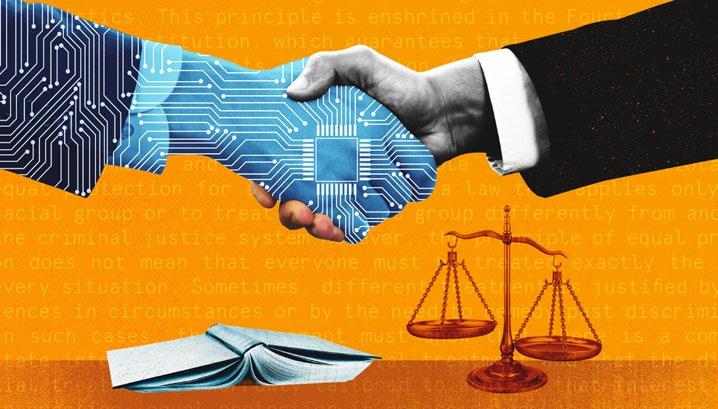
Although that version of the GPT program did not pass the exam, Katz made a prediction: it would be quite possible that a large-language model would pass the multiple-choice portion of the bar exam within the next 18 months.
It didn’t take long to prove that prediction correct.
Katz’s paper titled “GPT-4 Passes the Bar Exam”—co-authored with Michael Bommarito (Stanford CodeX/273 Ventures), Shang Gao (Casetext), and Pablo David Arredondo (Stanford CodeX/ Casetext)—demonstrates that GPT-4 can not only pass the multiple-choice portion of the exam, but it can also pass all parts of the Uniform Bar Exam (UBE), including the essay portion and the performance test.
“After we wrote our other paper in December, people would tell me that they believed AI would eventually pass the multiple-choice portion. But lots of folks said, ‘Well it is never going be able to do the essays,’” Katz says.
Katz and his co-authors graded the essay and performance portions. Katz says that they did their best to try to grade it fairly, but the computer scored so well on the multiple-choice portion that there was a lot of room for error in the essay and performance sections.
The program’s performance on the essay section was notable. In fact, he says that there was only one clear indicator that the essay was, in fact, written by a computer.
“There were basically no typos. The grammar is near perfect,” he says. “In the real bar exam, folks are working quickly and so there are likely to be typos and grammar mistakes, even on exams that otherwise receive quite high scores.”
Previous models would “hallucinate,” or confidently provide answers that were clearly incorrect, giving away that they were not human. Katz says that’s less common with GPT-4. In many other ways, the writing seemed like it could have been written by a student. He says it even drifted from the main topic in a very human way.
“In several of the problems, ChatGPT and, to a much lesser extent, GPT-4, will talk about a topic that’s related, but not really relevant, for the question as it was posed. That’s kind of what a student would do,” he says. “When I was a student, it’s what I would have done if I didn’t totally know the answer.” —Kayla
MolanderThis design is possible because of an innovative system, active flow control, that steers the aircraft by blowing jets of air onto different surfaces of the aircraft body that correspond to which direction the aircraft is turning.
Williams, professor of mechanical and aerospace engineering, led a team of Illinois Tech students and collaborators in the construction of the jet, which houses both conventional steering controls and a novel implementation of active flow control.

In October 2022 the group launched the jet from the Pendleton Unmanned Aircraft System (UAS) Range in Oregon for two nine-minute flights that demonstrated the success of the system.
The active flow control system actually provided more power than had been predicted from wind tunnel tests, allowing the pilot and team to test its ability to steer the jet at steep angles.
—Simon MorrowAs a young boy, much to his dismay, John Katsoudas (M.S. PHYS ’03) had a clearly defined role in the family business. It started with wrapping doughnuts.
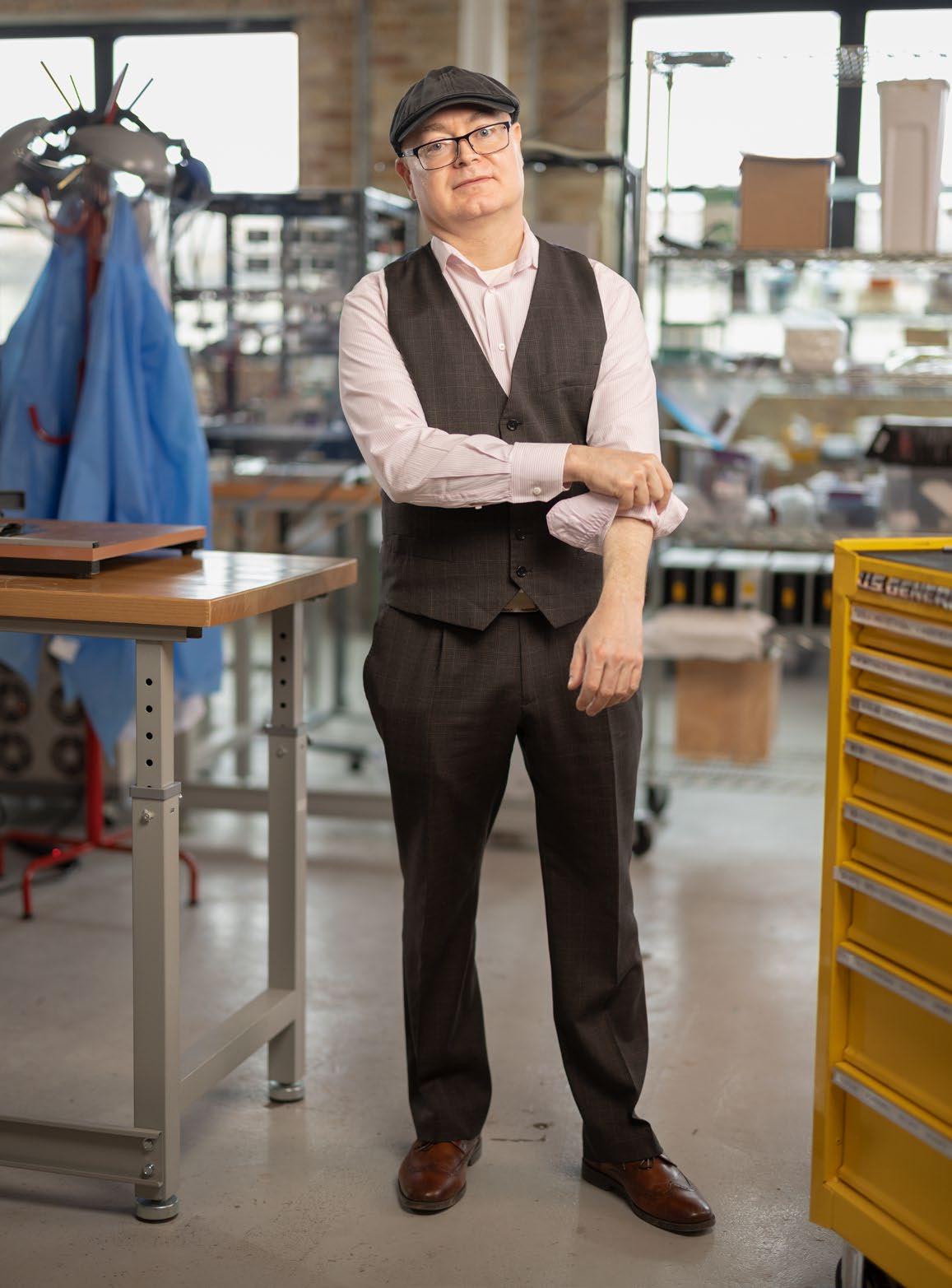
His father, a restaurateur, had a contract to make 20,000 doughnuts for Chicago Public Schools. Young John was the only one who could operate the machine that could wrap them. So that’s what he did for several sleepless days every summer.
“I hate doughnuts, I cannot tell you, I hate doughnuts,” Katsoudas now says. When anything broke at Sunny Donuts, Katsoudas’s father would wake him up at 3 a.m. to repair it. The pre-teen would stumble to a hardware store on Chicago’s South Side where the white-haired gearheads behind the counter would barrage him with advice, most of it good. At night he’d take apart the machines, numbering each of the hundreds of pieces so he could eventually put them together again.
“My dad couldn’t build a bookshelf if his life depended on it,” Katsoudas says. “The first time I put my hand on 120 Volts [of electricity] was at age 12.”
Now Katsoudas is messing with electricity again, co-inventing a fuel he hopes will save the world. He acknowledges the uphill battle, but says he’ll tackle it with the determination he earned growing up on Chicago’s South Side.
“The poor kid never got any sleep,” remembers his sister, Stella Katsoudas, a rock singer who sang under the stage name Sister Soleil, releasing multiple albums with Universal Records.
As a teen, John dreamed of making it big in music—or science. In high school he played drums in a band with his
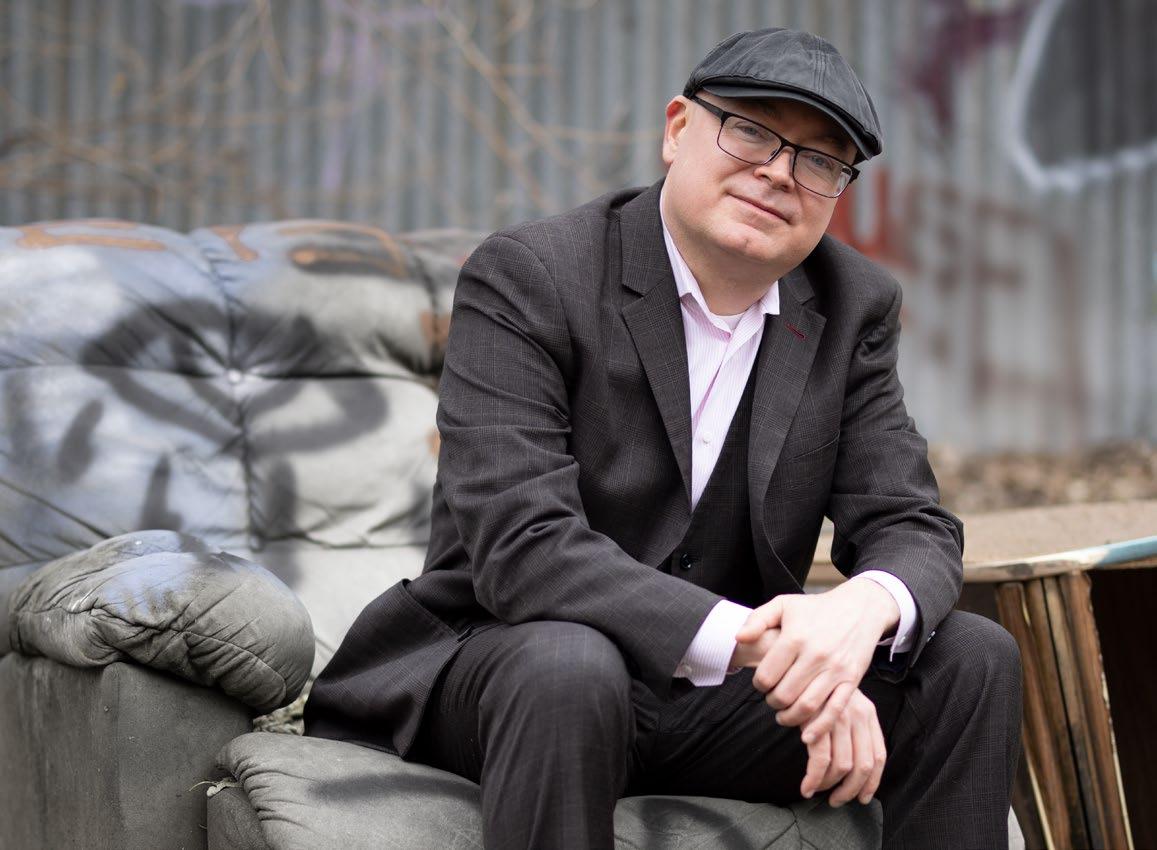
sister, hitting clubs across Chicago. But when he enrolled at Illinois Institute of Technology, he learned to love physics.
“I told Stella, ‘I can’t give up physics for this,’” Katsoudas says. But he almost did. He accompanied his sister on tour in her early years, managing her sound and lighting. After getting his bachelor’s degree, Katsoudas traveled to Burbank, California, to build a recording studio, sleeping on the concrete floor of the construction site for months. In time, the recording studio was built, but the founding partnership suffered, and dealing with recording artists grew to be more work than it was worth.
“Those guys worked their butts off building that studio, around the clock all the time,” says Edward Colver, a renowned punk rock photographer who shot more than 500 album covers and traveled to the Burbank studio often. “But his science…I think he had a life-long interest in that.”
“I never, ever intended to give up physics,” Katsoudas says. So he got in contact with Duchossois Leadership Professor Carlo Segre, a physics professor at Illinois Tech who brought him back into the physics program. And later, once he earned his master’s degree in 2003, John received a job offer from Segre to work as a beamline scientist for Illinois Tech at Argonne National Labs.
While there, Katsoudas was in charge of building research beamlines, first for the National Nuclear Safety Administration, then later for the broader materials science community. But what he really liked doing was tinkering.
John Katsoudas sits on a chair in the alley behind Influit Energy’s new lab space in the Kinzie Industrial Corridor on Chicago’s near West Side.“I’m a first principle builder. I can build anything based on first principles,” Katsoudas says. “That’s what physicists do. They’re all first principle builders, they just don’t know it.”
“John was always building something. And he was really good,” Segre says of Katsoudas’s various side projects, which range from a doughnut counter he built as an undergrad to an “open source” respirator created during COVID-19. Segre respected his colleague’s ingenuity so much that when John and his wife, Illinois Tech Research Associate Professor Elena Timofeeva, left Argonne to start their own business, he partnered with them.
The trio’s business, Influit Energy, has literally grown tenfold—from a 2,000-square-foot research space in Chicago’s West Loop neighborhood to a 20,000-square-foot industrial space in the city’s Kinzie Industrial Corridor.
Their goal is simple: to build a liquid-based electric battery to replace petroleum that will be safer and easier to implement than the lithium-ion model.
The battery relies on a fluid that contains billions of electrically charged nanoparticles, yet has a low enough viscosity to flow like water. Thus its name: nanoelectrofuel (NEF).
Rather than wait to charge the battery, an operator could just replace discharged fluid, which would be left to recharge and then fuel the next vehicle. Compared to a lithium-ion battery, John says, it’s not flammable, not explosive, and does not require drivers to wait longer than the several minutes they currently do to fill their tanks.
“We put fires out [with the liquid],” Katsoudas says. Plus, the battery relies on chemicals and elements that are “Earth abundant,” not limited to certain areas of the world, eliminating the need to negotiate mining or materials with foreign entities.
Influit has garnered developmental contracts and is currently testing the battery on an electric utility vehicle built by a Minneapolis company, a light tower for the United States military, and a Humvee.
“Is this viable for 100 percent penetration? Yes, because people want it,” Katsoudas says. “My day consists of strategizing, lots of meetings with sponsors. And doing my own experiments when nobody’s looking.”
He has traveled to Texas to meet with gas industry executives, because, he says, “The petroleum industry is the 800 pound gorilla that will fight for their markets. But they seemed receptive.” In particular, they seemed to like his technology’s potential ability to repurpose the industry’s infrastructure to transport what is essentially a rechargeable liquid fuel.
“I believe strongly that the biggest existential threat to our species is global climate change.…I’ve dedicated my life after leaving the music industry to science. But not science for science’s sake—for the betterment of the world,” he says.
For his wife and business partner, Katsoudas is like a walking battery himself. “I do have my weak moments. When I’m tired, he’s always like, ‘You got it.’ He brings you to where you’re seeing through the minutia,” says Timofeeva, Influit’s chief scientist and director of research and development.
Katsoudas chalks it all up to Chicago “South-Side persistence.” The two still live there—Katsoudas says he isn’t comfortable anywhere else.
“My dad taught me if you want something, go do it. Make it,” he says. “If you work hard and do something, this is the place to get it done.…You just have to tune out how much work it is.” •
Its inventors say that the experimental technology could power a wide range of machines and mechanisms, but it is perhaps easiest to show how it could potentially power an automobile. The technology “decouples” an electric vehicle’s battery energy storage (the liquid fuel, stored in scalable tanks) from the power source (the rest of the battery). A battery with more cells results in greater voltage, while larger tanks allow the car to be driven greater distances before refueling.
At a refueling station, the driver would remove the liquid fuel from the vehicle, while simultaneously pumping fresh, fully charged fuel into their vehicle. The used fuel would go to a recharging platform for rapid recharge.
The vehicle, or “mobile NEF platform”: Contains both a battery and liquid nanofuel in storage canisters to power it
Refueling station or apparatus: Would serve to remove the used, discharged nanoelectrofuel from the vehicle and replace it with new, fully charged nanoelectrofuel. The used fuel would be pumped to a recharging platform.
Recharging platform: Would rapidly recharge the discharged nanoelectrofuel to be used by the next driver
“Just because you live in a certain area, don’t make a certain amount of money, or [because of] the color of your skin, doesn’t mean you can’t go out and breathe clean air. It’s unjust.” —Cynthia Ferguson
 PHOTO BY EDGAR ARTIGA
PHOTO BY EDGAR ARTIGA
When Cynthia Ferguson (LAW ’00) received a governmental promotion of seismic proportions, she did exactly what those who know her expected her to do: she told no one.
“When she was selected as [the United States Department of Justice’s] acting director for environmental justice, I read about it in the newspaper. She had not even contacted her family,” laughs Kim Lambert, a close colleague of Ferguson’s who manages the environmental justice program at the U.S. Fish and Wildlife Service.
“That’s a big deal! That’s as high as you can go in federal government,” Lambert says. “Most people would have been calling to the heavens. But that’s not her.”
Ferguson seems allergic to fanfare. She’s humble and spiritual, sometimes praying for guidance in her work, which she refers to as “the calling.”
Long before “the calling” and shortly after getting her undergraduate degree, Ferguson took a job at a large, international chemical company.
It had been exciting studying mechanical engineering at Carnegie Mellon University, and now she was helping design chemical manufacturing equipment.
“In school I loved it, but in practice I was like, I don’t know,” she says. “I really wanted to do work that I felt added value. Had meaning.” Or more meaning, at least.
For her second assignment within the company, she began doing safety, health, and environmental work, ensuring that the company’s plants followed solid and hazardous waste laws.
She found the work much more satisfying.
“I really enjoyed this environmental work, but I didn’t know if I wanted to do it on the industry side,” Ferguson says. Still, she didn’t know what came next.
“I’d saved up nothing; it wasn’t in the plan [to go back to college],” she says, “But I knew I wanted to continue to pursue environmental work.” She began researching law schools, particularly ones with good environmental programs.
Chicago-Kent College of Law’s program was building a stellar reputation through what would eventually become its Environmental and Energy Law Clinic. Ferguson joined just as the clinic was earning its bones, fighting for small community groups on Chicago’s South Side against “Goliathan” opponents, from coal fire conglomerates to city hall. Locally, it was the rudimentary tip of the spear in the environmental justice movement.
“The cases [at first] seemed small, but definitely mattered,” Ferguson says.
It’s worth noting what Ferguson means by environmental justice, or what she reflexively calls “EJ.” When asked, her voice loses all hesitance.
“Fair treatment and meaningful involvement of all people regardless of race, national origin, or income level, relating to development and implementation and enforcement of laws,” she says. “You’ve got communities that weren’t allowed to use their voice to have a say in what was being done to their communities. Either they were being kept in the dark or weren’t told until too late, or they just weren’t listened to. That lack of political clout or power was taken advantage of.”
Then, she adds simply, “As you engage with communities, they will teach you what environmental justice means to them.”
Adds Quentin Pair, the DOJ’s former environmental justice
coordinator who Ferguson worked with and replaced when he retired in 2015, “At the bottom of the environmental justice well is trust; you cannot do this without the cooperation or at least understanding of community people. And they don’t [innately] trust the government.”
“Cynthia slid right on in,” Pair says. “She’s a very spiritual soul, she’s very protective of communities, and it’s best not to get stupid with her. They saw that, that she has skill and empathy.”
Ferguson was known for wearing walking shoes to community meetings, and staying until the last person had their say.
“A lot of people look at their job as nine to five. But she didn’t. She always stayed,” says Lambert.
Ferguson’s first contact with the DOJ happened when she interned for them in law school. It wasn’t glamorous, but she didn’t expect it to be. Both of her parents served the public: her father worked for the City of Baltimore, while her mother was a nursing assistant and heart monitor technician.
“Going through documents. That’s what I remember, going through documents, looking for evidence of how a company may have disposed of waste on a Superfund site,” Ferguson says.
It was glamorous enough for her to accept a job there as a trial attorney upon graduation.
“My whole life growing up was in that division,” she says now, 23 years later. “I was definitely blessed to find the area I wanted to focus on.”
The job demanded plenty of complex judgment calls. Ferguson remembers a safe drinking water case against a tribal government in charge of operating utilities on a reservation—a government that didn’t have a lot of resources, but seemed to care deeply about the environment.
“That taught me a lot from an EJ perspective,” she says. “There are times when you have to bring those types of enforcement actions, but at the end of the day, our goal and the tribal government’s goal was the same: human health.” They reached a cooperative agreement in the end.
By 2012, Ferguson was promoted to senior litigation counsel, leading EJ efforts for the DOJ’s Environment and Natural Resources Division. She also began taking part in larger, interagency working groups.
Finally, in 2022, the DOJ selected her to head its new EJ office and appointed Ferguson as the department’s environmental justice officer, allowing her to sit on the White House Environmental Justice Interagency Council. The demands of the position mean she no longer handles cases herself, but instead supports the DOJ’s various divisions in incorporating environmental justice tenets into their enforcement strategies.
It’s a hefty and often high-altitude responsibility, but Ferguson keeps her eyes and thoughts on the ground game.
“Everyone deserves clean air, water to drink, a safe place to go outside and play and not worry about contaminated soil, and if they want to fish in the stream, not to worry about eating it,” she says. “Just because you live in a certain area, don’t make a certain amount of money, or [because of] the color of your skin, doesn’t mean you can’t go out and breathe clean air. It’s unjust.
“The reason I agreed to do this is to lift up this issue so others who may not be engaged, get engaged,” Ferguson adds. “Those that dedicated their lives to this work, it really is a calling.” •
Growing up on the Northwest Side of Chicago, Michael Plesniak (ME ’83, M.S. ’84) found himself following in the footsteps of his father, a machinist who immigrated to the United States. He spent much of his adolescent and teen life working on cars or “taking stuff apart.”
With that as his foundation, a career in mechanical engineering made sense; Plesniak figured that he would settle into a career designing auto parts or other mechanical systems. That was until he was introduced to a side of mechanical engineering that he was, until then, unfamiliar with: fluid dynamics, or the study of the flow of fluids (liquid and gas).
The introduction of fluid dynamics through an undergraduate research experience not only intrigued Plesniak, but also set him on a three-decade (and counting) career path in academia, with time spent at NASA and the National Science Foundation.
“I remember [former Illinois Institute of Technology]
Professor Mark Morkovin would say, ‘Well, if you really want to do research, you have to get a Ph.D. That’s the union card,’” says Plesniak, who earned his “union card” at Stanford University. “When I entered college, I thought I would get a bachelor’s degree. I would go out and become an engineer and work at GM or an automotive company. The undergraduate research experience is what set me on the path to, well, there’s this whole exciting area of research to be done.”
Plesniak, who is a professor and chair of George Washington University’s Department of Mechanical and Aerospace Engineering, now focuses his fluid dynamics research on human speech production and cardiovascular flows.
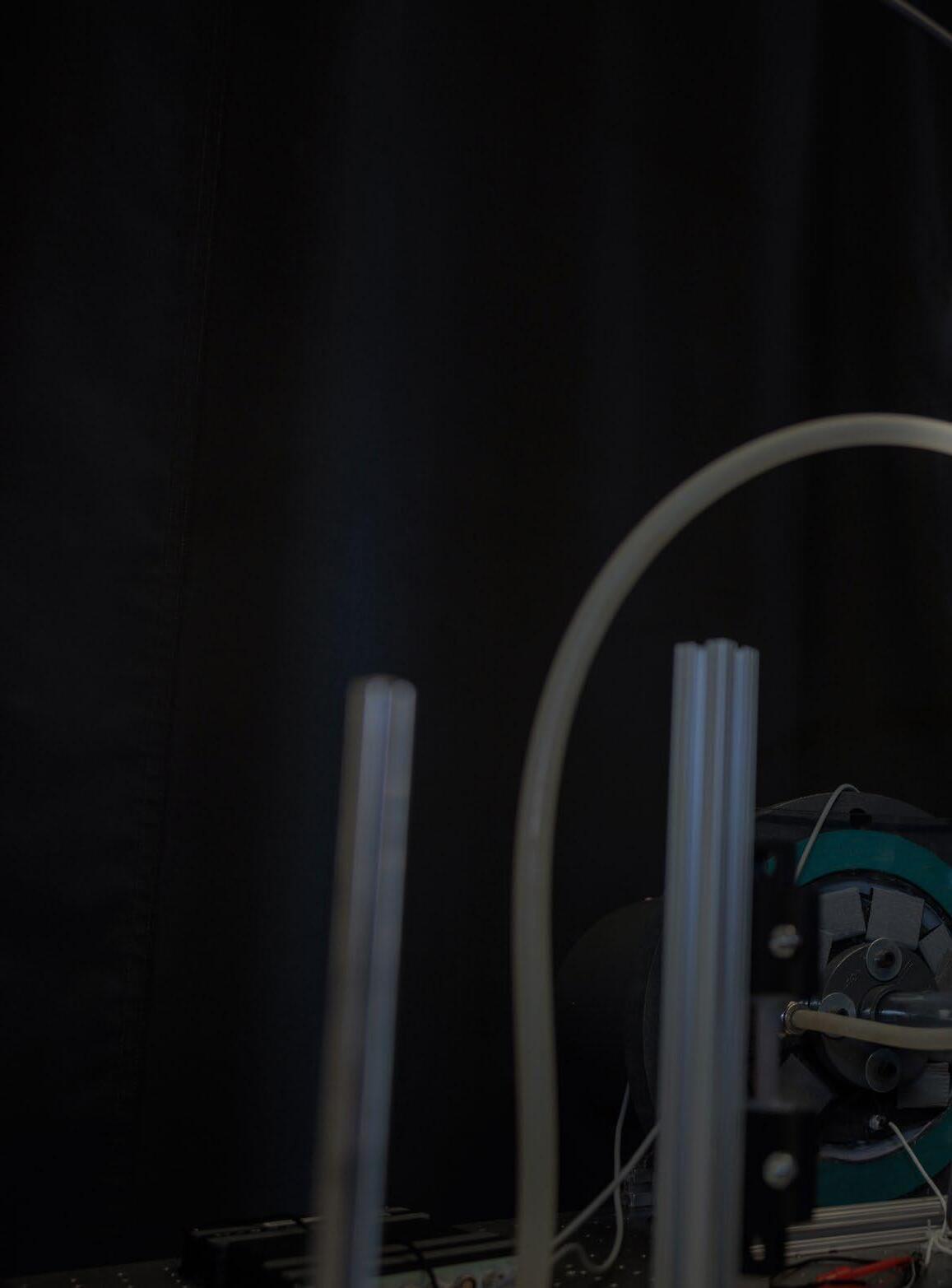
Plesniak’s initial foray into the field was through turbulence and turbulent flow physics, but he “was always interested in biological flows in the body.” At Purdue University, where he first became a professor, Plesniak began to research phonation, or the production of speech sounds.
His work evolved from there.
Eventually, Plesniak began to work with doctors and surgeons on multiple issues surrounding the vocal folds, including folds that were paralyzed or that had developed polyps, both of which can affect speech.
Surgeons have had a procedure to treat paralyzed vocal folds, which includes an insert being put on the vocal fold to improve speech. But the procedure, a medial laryngoplasty, was something of a trial and error, with a significant number of patients having to endure multiple procedures because the first (or second or third) didn’t have enough of an effect.
Plesniak’s experimental work, when combined with clinical results, helped in the development of computer simulations that surgeons can now use to maximize positive outcomes.
“As medicine’s becoming more and more high tech and they have more imaging capabilities and more control with robotic
surgeries, physicians are trying to make it more predictive so that they can really plan what they’re going to do and have a better idea of the outcome rather than having to iterate on it afterward,” Plesniak says.
Exploring biological flows has even allowed him to incorporate concepts, such as turbulent flows, that tie back to the ideas that were his introduction to fluid dynamics. His work in cardiovascular flows—which are supposed to be smooth and regular—examines issues that lead to blockages and can result in stents being put into the coronary arteries.
The cardiovascular flows work has also led to real-world impact, including working with a startup to develop a product that prevents kidney failure during cardiovascular procedures such as coronary artery bypass. The product that Plesniak helped contribute to is still in use today.
“It’s interesting—I’m of a much older generation than his— but [Plesniak] has the same style we have at Caltech, looking at problems from a really basic [perspective] and trying to translate it to applications,” says Morteza “Mory” Gharib, Hans W. Liepmann Professor of Aeronautics and Medical Engineering at Caltech. “He’s really into understanding the basic research aspects of the work.”
Plesniak’s impact extends beyond his own work, too.
He leads George Washington’s Center for Biomimetics and Bioinspired Engineering, which aims to take the lessons that can be gleaned from nature and its evolution to inspire engineering decisions. One of its current projects includes studying how sea lions swim.
“They swim a lot differently than any other sea animals. Most fish and other animals mostly get their thrust from their tails, whether they move them side to side or up and down. Sea lions do something almost like a breaststroke with their fore flippers,” Plesniak says, adding: “Right now we’re making robots based on that. One application is designing amphibious vehicles.”
It’s a fitting continuation of a career that has taken Plesniak in directions that he would have never thought of growing up in Chicago’s Belmont Heights neighborhood and while taking auto shop classes at Lane Tech College Prep.
While the work is fundamentally different from designing car parts, Plesniak still remains firmly entrenched in his mechanical background.
“Everything’s related. There’s not that big of a difference between the mechanical structural side and the fluid side of mechanical engineering,” he says. “There are many other things in mechanical engineering that people do, but as the problems get more and more challenging and the world’s more interdisciplinary, we don’t work as individuals as much as on teams. All these different disciplines are brought to bear on these problems. And that’s really exciting.” •
 BY ANDREW WYDER
BY ANDREW WYDER
Like some prodigious inventors, Michael Buonanno (AE ’01) truly understood the importance of his project when his first child was born.
He’d just started working on a new supersonic aircraft design for NASA, and one evening at his Southern California home, he was trying hard to convince his newborn to catch some sleep. He eventually succeeded—then imagined a plane flying overhead, breaking the sound barrier. All his effort with his newborn, destroyed with an indelibly distinct sonic boom.
“That’s when it went from, ‘What’s the big deal?’ to, ‘Absolutely, this would not be acceptable,’” Buonanno laughs.
His decade-long project, the X-59, is the pinnacle of his passion: from a kid who loved drawing airplanes all the way to his current gig as an air vehicle lead and fellow at Lockheed Martin, he has been fascinated by advances in aviation. Advances that along one vector at least—speed— halted in the 1960s. Eventually, sonic booms led to international bans on speeds above roughly 700 mph over land.
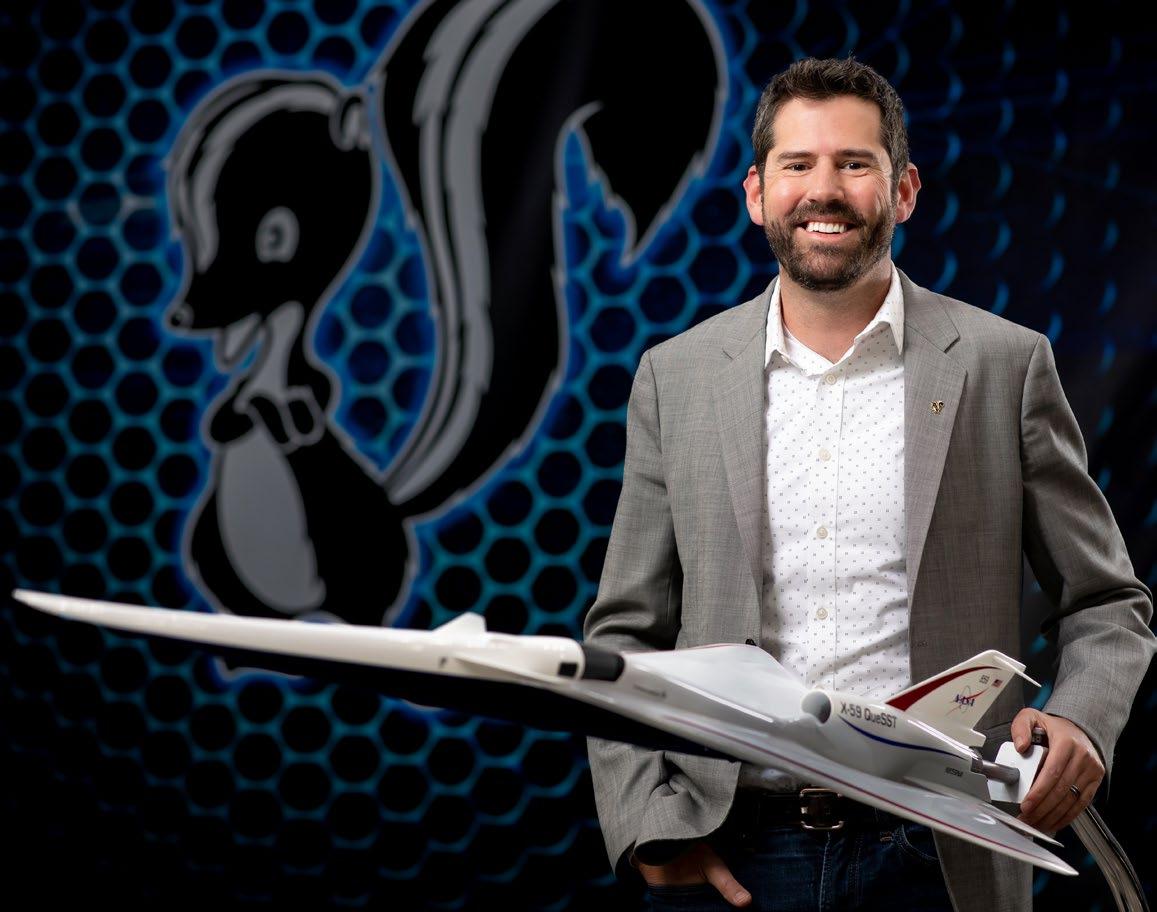
But Buonanno, heading a multidisciplinary team under a NASA contract, wants to change that.
“We could get out of this stagnant period that we’ve been in since the 1960s, where air travel has not gotten any faster and really has gotten slower,” the lifelong aircraft designer says. “We’ll get where we want to go more quickly.
“We’ll move away from the sonic boom altogether.”
Born and raised in upstate New York, Buonanno became fascinated with planes after an influential elementary school history teacher spoke on the importance of aviation during World War II. Shortly thereafter, he devoured a book that his mother bought on the subject, cover to cover.
“I was convinced at a young age that I wanted a career in aviation. I really had no ambiguity,” Buonanno says.
He initially wanted to be a pilot, but an accident at age 11, when he fell through a glass door and almost bled out, resulted in some loss of mobility in one of his arms. So he pivoted to engineering.
After graduating from Illinois Institute of Technology in the midst of a weak job market, he decided to pursue graduate school, culminating in a Ph.D. from Georgia Institute of Technology in 2005. He started at Lockheed Martin immediately after graduation as a conceptual design engineer. There, he became enmeshed in one of the most highly specialized units in the company.
Lockheed Martin’s Advanced Development Programs, also known as ‘Skunk Works,’ got its pseudonym during World War II when the company’s Burbank, California, facility grew from 3,000 people to about 100,000. Pressed for space, it placed a specialized unit in a circus tent, right next to a chemical processing plant.
The unit was charged with tackling seemingly impossible
“special mission needs,” with its first project being the P-80, the first United States jet fighter to go into large-scale production. Other hallmarks include the U-2 spy plane and Buonanno’s favorite, the SR-71.
“It was designed for one thing: to go fast. And it did that very successfully,” he says.
Not only was the SR-71 sleek, and in Buonanno’s mind, beautiful, it was the pinnacle of speed—the fastest plane ever flown. Or, with all the caveats, the fastest manned, air-breathing airplane. Built in 1963 and capable of Mach 3—three times the speed of sound—it was where worldwide advances in speed stopped.
“The progress in speed was more or less like the progress in computing power: it roughly doubled every decade, from 1903 [when the Wright Brothers flew 36 meters in 12 seconds] until the 1960s,” Buonanno notes.
That’s when speeds breached the 767 mph sound barrier, and progress came up against consequence. The environmental impact, or “acoustic disturbance,” of sonic booms made such speeds over land untenable. Sonic booms stay with aircraft as they fly, trailing a 50-mile-wide swath of acoustic shock. Internationally, there are now bans on going faster than the speed of sound over any land mass.
For the last decade, Buonanno has been trying to figure out how to break the sound barrier over land. Quietly.
Shock waves are a near-instantaneous rise in pressure and temperature. Each individual surface, edge, antenna, or crevasse on an aircraft creates a small shock wave.
“Many of our tactical fighters—F-16s, F-18s—when they go supersonic, all those shock waves coalesce, focus together before the shock waves hit the ground. So instead
of a series of small disturbances, they focus on one very loud double-bang,” Buonanno notes.
The goal of the X-59 project is to disperse all those shock waves over a gradual time frame, so people on the ground don’t begrudge the muffled “boom.” The PLdB (a different industry measure of decibels) of a Concorde airplane breaking the sound barrier was 108. The X-59 is projected at 75.
“You can’t make [the sonic boom] completely go away, but you can make it so quiet that it blends into the background noise of everyday life,” he says.
“The longer you spend in this project, the more you appreciate we could potentially change the way the world travels,” says Ryan Reynolds, senior program manager for the X-59 project.
Reynolds says Buonanno, whom he has known since they both started at Lockheed Martin in 2006, is a calm cornerstone for the team on the high-pressure project: smart, a good listener, and supportive.
“In the heat of schedule and cost pressure and technical challenge, he manages to keep more of a family feel than a hierarchical one,” Reynolds says.
They’re now building an experimental aircraft, or X-plane, which they hope to fly later this year. If successful, Buonanno says, NASA—working with international regulatory organizations—could potentially work to remove the flat-out ban on supersonic travel over land.
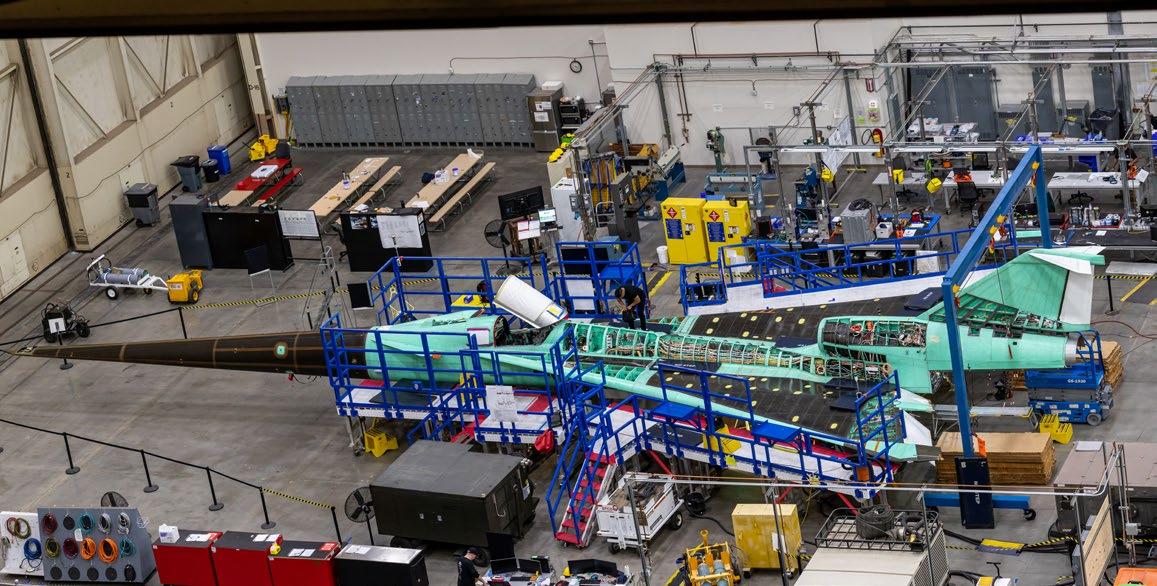
“If you fly from the west to east coast [of the U.S.], which I do quite regularly, it now takes six hours. Round trip for a meeting is basically three days,” he says. Supersonic travel over land could potentially cut travel time in half, shortening such trips by a day or even two.
“It’ll mean that we can get back on the trend of continuous advances in terms of travel speed until the 1960s,” Buonanno adds. “And it’s not going to wake up your sleeping baby.” •
Watching an idea transform from a design on paper into a beautiful and integral part of a community is what keeps Kris Sorich (M.A.S. LAND ’14) in the landscape architecture business.
In a prior life, that wasn’t the case, as Sorich constantly saw her landscape creations wither. Plugging away in the private sector, she saw meticulously planned landscaping designs fade away as owners neglected maintenance. Then, in 2000, an open position with the Chicago Department of Transportation (CDOT) provided an opportunity to ensure that her designs would remain integrated in the community for decades to come.
Now, every green-space project involving CDOT, from major developments to local road changes, comes across Sorich’s desk in one way or another.
You can thank her for the new urban pollinator habitats at what was once the most dangerous intersection in Chicago: at Damen, Elston, and Fullerton streets. Sorich’s biggest recent project is the Wells Wentworth Connection project that is part of the The 78 development that runs along the Chicago River, linking the city’s Chinatown neighborhood to the South Loop area. Beautification near the Cermak Road area is already complete, and after nearly a decade of work the pedestrianand bike-friendly roadway should open in 2023.
She’s particularly proud of the design of a retaining wall supporting two bridges. “This is the wall that holds the plaque with all the CDOT contributors to the project, including myself, which is the first time in history a landscape architect was included,” Sorich says.
These are only a few of the hundreds of designs that Sorich has touched.

The path that Sorich took to CDOT was filled with fits and stops. After working in finance for a decade, earning a degree, and eventually becoming a senior auditor, she wanted a way out. “I was searching for the negative; I don’t think I could have done that forever,” she says.
Thus began Sorich’s search for a new chapter in life. She started by writing down a list of everything that she enjoyed—down to the smallest hobby. Gardening earned a spot on the list, as she had taken to planting flowers. This idea sparked enough interest to send her back to school to become an “architect of the land.” She explained that, “If you think of a landscape painting, you see Earth and its natural environment and man-made environments as a whole. Landscape architects work their magic within that realm.”
Sorich enrolled at Joliet Junior College and graduated with an associate’s degree in horticulture and landscape in 1996. “I quit my job, took a pay cut, and started my own business,” she says.

Sorich’s landscape architecture business didn’t last long. She was “doing more accounting than anything,” and left for Gethsemane Design Group, where she worked on residential landscaping projects. She found success, bringing in more than $1 million in project sales in her three seasons of employment.
But Sorich also saw the depressing aftermath of her projects: the flowers, shrubs, and trees that she hand-picked for each design would falter and die. “I would pass these houses I designed all this work for, and they were not maintained,” Sorich says.
Then she heard about the job at CDOT, which appealed to her. However, she did not have a landscape architecture registration, a title awarded solely by the state. So, she enrolled at Illinois Institute of Technology’s College of Architecture to pursue a master’s degree in landscape architecture. From 2007 until her graduation in 2014, she studied around her work schedule, co-parenting two children and caring for her husband while he battled cancer to earn that degree. “It was a crazy time, and I still don’t know how I managed it,” she says.
Sorich’s educational journey left a deep impact on her work. “Anyone who knows my story would mention the seven years I spent at [the College of Architecture],” she says.
Sorich now heads the landscape management section in CDOT’s engineering division; she’s also the sole

employee in the department that holds the state-mandated landscape architecture title.
condition and Chicago’s hostile summerwinter weather cycle.
She advocates for environmental and renewable technologies while delving into aspects such as land grading and drainage, green infrastructure, stormwater management, and placemaking on the grand scale.

“Advocating for her involvement in a project early makes a big difference in the final project,” says Bridget Stalla, a former CDOT employee who worked with Sorich for two decades. Stalla notes that, at times, developers and subcontractors submitted project drafts to the city without consulting Sorich, to their detriment.
“In a sea of engineering and construction, Kris always sees something we don’t because it isn’t our focus. She can see the beauty in things that people wouldn’t point out,” Stalla adds.
Sorich has had to move and adapt with Chicago over the years. That meant integrating cycling into road projects as well as increasing community outreach to incorporate neighborhood desires.

When she gets involved in a CDOT project early, she can guide a development team by showcasing how to incorporate landscape architectural elements in ways that are functional and aesthetically pleasing, while also building safe and complete streets. She also advises landscape architect design consultants as to what plant species thrive in the urban
Outside the office, Sorich advocates for landscape architecture in the civic sector—something she says is sorely lacking. She points out the overall lack of recognition for civic projects in the wider architectural field. While architects in other areas get their names on a plaque, landscape architects often remain unsung heroes.
“What we do in public practice is way different than working with a design firm. It’s about coordination, community outreach, and long-term ownership,” Sorich says. “I try to make sure everyone understands landscape architecture, as a discipline, is not just about pretty flowers.”•
Kris Sorich stands in the middle of a newly built road in The 78 development on Chicago’s near South Side. Sorich has played a key role in the development of landscape architecture components of the project, including the pattern of the retaining wall [as shown on the right] and the black gates on the side of the road [left]. PHOTO: TIM KLEIN A look at some of Kris Sorich’s work: tulips planted on Michigan Avenue in Chicago [left] and an overlook with native pollinator plantings at the intersection of North Avenue and Cherry Street in Chicago [right]“I try to make sure everyone understands landscape architecture, as a discipline, is not just about pretty flowers.” —Kris SorichPHOTO: KRIS SORICH
JAMES N. SALAPATAS (IE ’55), Colorado Springs, Colo., has been included in the Marquis Who’s Who biographical volumes.
KANJI SAHARA (EE ’56), Torrance, Calif., was featured on CNN. As a kid, America sent him to live in a barracks with 18,000 others. Now, decades later, he’s getting an apology.
PIER C. BORRA (MET ’61), Harbor Springs, Mich., gifted the Borra Family Learning Center as part of the Building Tomorrow Together campaign at North Central Michigan College.
HAYDEN M. ARONSON (PHYS ’64), Corvallis, Ore., received the 2022 Majestic Spotlight Award from the Majestic Theatre.
LEWIS THIGPEN (M.S. MECH ’67, PH.D. ’70), Alexandria, Va., received the Illinois Institute of Technology Mechanical, Materials, and Aerospace Engineering Alumni Award on April 8, 2022.
TAKAO KOBAYASHI (M.S. MECH ’69, PH.D. ’72), Morgan Hill, Calif., was inducted into the SRI International Hall of Fame in October 2022 in recognition of his advancement of material fracture analysis techniques and development of FRASTA (fracture surface topography analysis).
PETER P. HANIK (CHE ’72), Houston, has written a book, Type 3 Solutions: Problem Solving for Competitive Advantage.
ROHINTON M. RIVETNA (M.S. IE ’74), Hinsdale, Ill., was featured on Zoroastrians.net on “The Good Minds Project-Roshan and Rohinton Rivetna.”
ELAINE C. THOMOPOULOS (PH.D. PSYC ’74), Burr Ridge, Ill., was the editor of Modern Greece, a thematic encyclopedia recently published by ABC-CLIO.
STEVEN M. ODRE (LAW ’77), Westlake Village, Calif., was named senior vice president, general counsel, and secretary of Amgen.
STEVEN L. GLICKMAN (ARCH ’78), Bethlehem, Pa., was elected chairperson to the Lehigh Valley Planning Commission and celebrated his 22nd year at his firm, Steven Glickman Architect.
JEFFERY M. LEVING (LAW ’79), Chicago, published the article “More Research is Breaking New Ground on Often-Overlooked Group: African-American Youth” in the Chicago Sun-Times on December 14, 2022, and was a guest on Daytime Chicago.
HEIDI L. RANK (ARCH ’81), San Rafael, Calif., was promoted to senior project manager at Swinerton for construction renovation projects.
H. P. MORRIS (LAW ’83), Kenilworth, Ill., was an Advocate for Diversity Honoree at the 2022 Diversity Scholarship Foundation’s Unity Gala and Awards Ceremony.
NANCY E. PARIDY (LAW ’83), Evanston, Ill., was quoted in the Chicago Tribune article “Inside Streeterville’s Shirley Ryan AbilityLab, the World-Renowned Rehab Facility Treating Patients
like Danny Golden and Cooper Roberts” on August 27, 2022.
STANLEY N. SCHACHNE (ARCH ’83), Davie, Fla., was presented with the 2022 Community Service Award from the Fort Lauderdale Chapter of the American Institute of Architects.
JAMES E. MURAIDA (ME ’84), Mokena, Ill., has been appointed vice president at Sargent & Lundy, an engineering firm in Chicago.
PAUL N. KRYSTOSEK (PH.D. CS ’86), Murrysville, Pa., has retired.
MICHAEL J. BERTUCCI (ARCH ’89), Chicago, was elected treasurer of the Justinian Society of Lawyers.
CRAIG S. DONOHUE (LAW ’89), Sea Island, Ga., was reelected to the Options Clearing Corporation Board of Directors as executive chairman.
JAMES P. NAGLE (LAW ’89), Oak Brook, Ill., has restored the Drake Hotel and has it ready to reopen in Oak Brook, according to ChicagoBusiness.com and myinspiredesign.com.
VICTORIA K. MEYER (CHE ’90), Spring, Texas, hosts a weekly podcast, The Chemical Show, at thechemicalshow.com.
SCOTT M. CONWELL (ARCH ’91), Naperville, Ill., was awarded the Cesery Award for his contributions to the ceramic tile industry by the Tile Contractors’ Association of America.
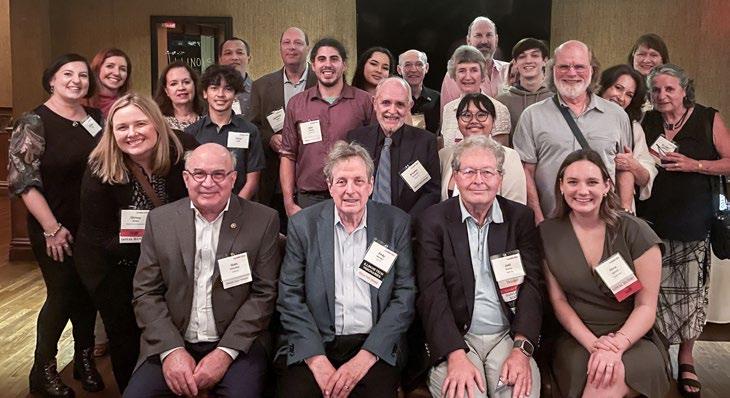
MATTHEW P. WALSH (LAW ’92), Indian Head Park, Ill., was elected to the Chicago Bar Association’s Board of Managers and was named co-chair of CBA’s 2022 Pro Bono Week.
JUNJIAN TANG (ARCH ’93), Lisle, Ill., appeared on a podcast by Business Office Systems discussing immigrating to America, architectural excellence, and paying it forward.
DAVID G. WIATROWSKI (M.S. EE ’93, C.E.R. COMM ’04, M.A.S. ECE ’08), Woodstock, Ill., was awarded the 2021 Motorola Solutions Business Patent of the Year by Motorola Solutions, Inc. on March 11, 2022.
JONATHAN P. ATWOOD (CHE ’96), West Linn, Ore., has joined Trillium Engineering as chief executive officer.
KELLY L. FRANZNICK (M.D.S. DSGN ’96), Bainbridge Island, Wash., had the company that he co-founded, Seattle UX company Blink, acquired by India-based information technology services giant Mphasis.
GRACE HSU (ARCH ’96), Corte Madera, Calif., designed a seismic buildout for Stanford Health Care Hospital.
GREGORY T. WYLER (LAW ’96), Stuart, Fla., raised $50 million in funding for his new startup, E-Space.
NAFISA I. BHOJAWALA (DSGN ’97), Seattle, Wash., started as the UX leader for Google Kubernetes Engine and Anthos in September 2020.
JONATHAN A. CARSON (LAW ’97), Los Angeles, rebranded Bankruptcy Management Solutions as Stretto.
RAY C. SCHROCK (LAW ’98), Rye, N.Y., was named a top restructuring lawyer for 2022 by Business Insider
GWENN PETERS (ME, AE ’02), Milwaukee, was named one of Milwaukee Business Journal’s 40 under 40.
CLAUDETTE SOTO (ARCH ’02, M.A.S. STE ’05), Evergreen Park, Ill., was appointed by former Mayor Lori Lightfoot to serve on the Chicago Plan Commission. The City Council subsequently approved the appointment on September 21, 2022.
KAVIN AMMIGAN (ME ’04, M.S. MAE ’07, PH.D. ’12), Naperville, Ill., received the United States Department of Energy Early Career Award for his research at FermiLab.
JULIE A. CHANDLER (CE ’07, ME ARCE ’16), Aurora, Ill., started a new position at Resource Innovations as an energy engineer IV.
MARGARET P. BATTERSBY BLACK (LAW ’08), Elmhurst, Ill., was named managing partner of Levin & Perconti, a law firm specializing in nursing homes, medical malpractice, and catastrophic injury and death cases.
WHYNDE KUEHN (M.S. EM ’09), Chicago, published her first book, Strategy to Reality: Making the Impossible Possible.
CHIA JUI WANG (M.A.S. ITO ’09), Northville, Mich., is now the vice president of global supply chain for Terumo Cardiovascular.
EVAN W. JAHN (EM ’10), Chicago, unveiled his new brand: Jahnunbounded by convention/energized by the future.
PARAM I. SINGH PAL (M.A.S. MAE ’10), Inverness, Ill., has launched a new product through Enterprise Atlas.
KIRTIPRAKASH KONDIPARTY (PH.D. CHE ’12), Sugar Land, Texas, has moved to Houston to work for ChampionX.
BRUNO R. MARASSO (LAW ’12), Chicago, was installed as the 2022–23 president of the Justinian Society of Lawyers.
REI C. SCHULTZ (ARCH ’14), Bothell, Wash., has married Erik Schultz (ARCH ’13).
MICHAEL J. RIVICH (BA ’20, M.S. MANL ’20), Whiting, Ind., has become part owner of Rivich Auction & Estates.
URVI CHANDRESHKUMAR SHETH
(M.A.S. CS ’20), Chicago, hosted a webinar on November 2, 2022, about racial/ethnic disparities in the observed COVID-19 case fatality rate among the United States population.

MEREDITH B. LUDLAM (ARCH ’21), Omaha, Neb., has joined CPL, an architecture, engineering, and planning firm as an architectural designer.
HITANSHU R. RAMI (CS ’21), Schaumburg, Ill., has joined Amazon as a software development engineer.
MICHAEL WOJCICKI (CS ’21), Schaumburg, Ill., who graduated summa cum laude in May 2021, has joined Google as a software engineer.

Share Your News
We want to hear from you. Send us your class note Submissions may be edited for style and brevity.
The Illinois Tech Alumni Association hosted a regional event in Seattle on March 7, 2023, for alumni to reconnect and learn more about the university.While growing up, Lexi Detweiler (PHYS, ASPY, M.S. HP ’21) listened to her father spout random tidbits of information from his various STEM-related careers. He’d gone from being an architect to working in information technology and artificial intelligence. They’d watch space shuttle launches together, and always seemed to be starting a new project together.
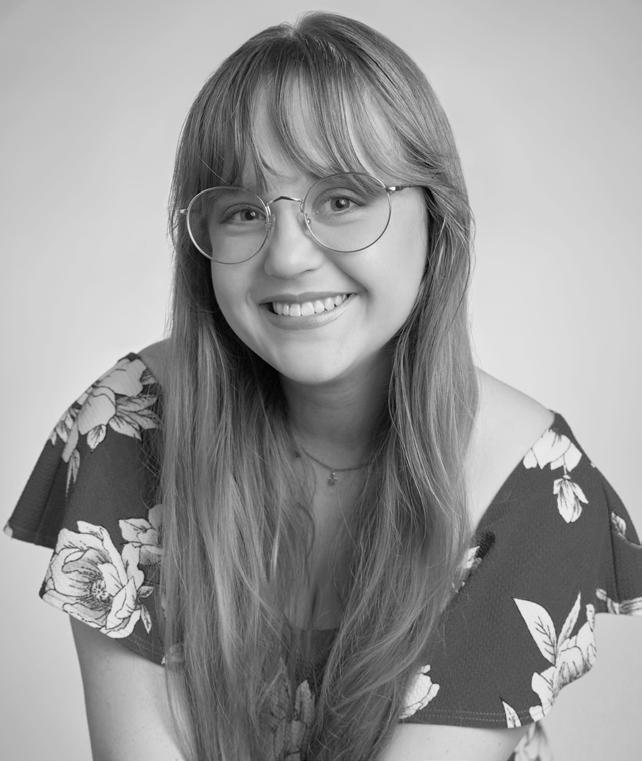
“He always had lots of cool facts up his sleeve,” Detweiler says, and that barrage of arbitrary information ironically caused her to focus on one field of science.
“Everything boils down to physics. It always felt like the most elementary science to me,” she says.
Now, just two years after graduating from Illinois Tech, Detweiler’s career has become critically important.
She works at the Y-12 National Security Complex in Oak Ridge, Tennessee. It was built as part of the Manhattan Project, and houses facilities that specialize in the processing and storage of uranium. Those working at Y-12 have three primary missions: to fuel the nuclear-powered United States Navy, to help maintain its nuclear stockpile, and to conduct nuclear non-proliferation work.
To call her focused would be an understatement.
An employee of Consolidated Nuclear Security, which operates Y-12 in support of the National Nuclear Security Administration, she helps to make sure there are adequate protections in place to house and process
all that uranium. Those protections can include everything from gloves and respirators to several feet of lead, depending on the type and quantity of the radioactive material being dealt with.
“Health physics has many facets. It’s not just worker safety, there’s a lot of other concerns,” says Craig Schwartz, Detweiler’s manager. “There’s also environmental issues, discharge, decommissioning, and decontamination.”
With so much work to cover, Detweiler’s enthusiasm for the field has been a breath of fresh air, Schwartz says.
“She’s taken the opportunity in just over a year’s time to take on as much as she can to learn the different facets of radiological engineering,” he says. “She’s very inquisitive, and asks good questions to really learn the profession.”
Detweiler has made her mark in other ways.
Last summer, she traveled to a test facility in Nevada with dozens of scientists from other labs across the globe to participate in a “criticality” measurement exercise. They used various methods to determine how much radiation was put out by a contained atomic chain reaction—or what’s called a “criticality” in her line of work.

“I’m really lucky that Illinois Tech had that health physics program because it’s not very common,” Detweiler says. “There’s not a lot of programs like that, and it really covered exactly the type of work we’d be doing, and exactly what I wanted to do.”
—Tad VeznerThe Gunsaulus Society recognizes donors who have made an estate commitment to Illinois Tech. The simplest and most common estate gift is a statement in your will or trust. Gunsaulus Society members enjoy the following benefits:
• Recognition at events and in publications

• Special event invitations
• News and updates from the university
For more information or to notify us of your planned gift, please contact us at giftplanning@iit.edu or 312.567.5028.
We can help you find the type of estate gift to best fit your estate planning needs and charitable interests.
If so, charitable gift annuities (CGAs) might be a solution for you. They provide you with a fixed-income stream and create a charitable gift to Illinois Tech at the end of your life. First, you make a donation to Illinois Tech and receive a partial tax deduction. Then, your gift is invested, and you receive a fixed monthly, quarterly, or annual payout for the rest of your life. Annuity payments may be partially tax-deductible. At the end of your life, Illinois Tech receives the remaining amount in the account. CGAs are advantageous right now, because:
1. The annuity rates increased again in January for the second time in six months, resulting in higher annuity payments.
2. Annuity rates are higher than many alternative fixed-income options at 5 percent to 9.7 percent (depending upon your age).
3. The IRS discount rate has also been rising, increasing the tax deduction the donor takes upon setting up a CGA.
1. You make a minimum gift of $10,000 in cash or stock to Illinois Tech.
2. You and/or your spouse or other beneficiary receive fixed annual payments for life.
3. You receive a charitable income tax deduction at the time of your gift.
4. Your gift benefits Illinois Tech upon your death.
The SECURE Act 2.0 passed on December 29, 2022, and includes the following changes to legislation that impact charitable estate planning:
• The age at which retirement account owners must begin taking a required minimum distribution (RMD) increases to 73 in 2023, and will increase to 75 in 2033.
• Starting in 2024, RMDs will no longer be required from Roth accounts in employer retirement plans.
• You can still make a qualified charitable distribution (QCD) from your retirement account beginning at age 70½.
• Beginning at age 70½, you can now make a one-time QCD of up to $50,000 to a charitable gift annuity or a charitable remainder trust. This counts toward your RMD.
André Nogueira (Ph.D. DSGN ’19) has tackled design from every angle that you can think of.
He started his career working for several architectural firms, then an interior design firm, then a landscaping firm, then for a furniture design company. He then went on to urban design, always focusing on his family’s humble beginnings and those who would be most affected by a project.
“At the time I was growing up [in Brazil], there were a lot of international organizations taking over the market and low-cost labor. You could see this was not doing very much good,” Nogueira says. “Either you work for them and contribute to a reality that is not sustainable but you benefit yourself, or you try a different path to explore alternative systems.”
Nogueira received some national recognition for helping to redevelop favelas—informal settlements consisting of densely packed, often self-built houses—in Rio de Janeiro and São Paulo in Brazil, while also doing development work in the rural parts of the country, from the farmlands to the banks of the Amazon River.
But he began noticing problems.
Mountains got leveled to offer new residences a better view. Rivers were dried or rerouted to create aesthetically pleasing ponds. Local grocery stores were closed when larger conglomerates moved in.
“When you do that, you’re not accounting for the real costs. You’re creating a debt for future generations,” Nogueria says. “You can make a development extremely profitable—or great, with a great profit.”
Nogueira decided to co-found his own urban design studio, and strove for sustainability—increasing
green areas, designing sidewalks that redirect water in the right way, creating new waste management systems. Still, over time, Nogueira found that he was falling prey to the same driving factors as in his previous jobs. He became motivated to influence the design process at a higher level.
Shortly after graduating with a Ph.D. from the Institute of Design (ID), he co-founded the Design Laboratory at the Harvard T. H. Chan School of Public Health.
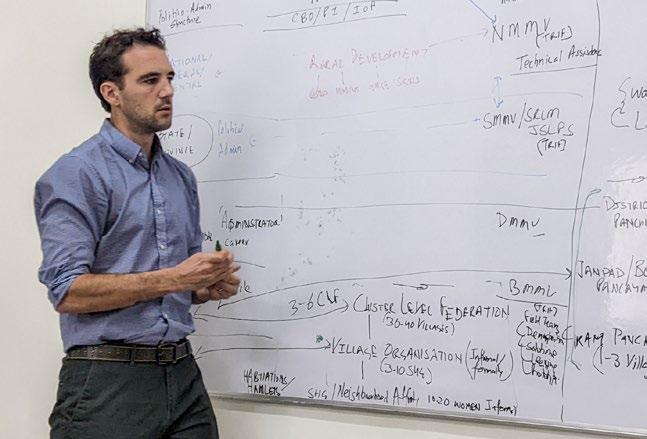
His research there caught the attention of the Bill and Melinda Gates Foundation, the United States Agency for International Development, the U.S. Fish and Wildlife Service, and more. Most recently, he was awarded the 40 Under 40 Public Health Catalyst Award by the Boston Congress of Public Health.
He has since focused on developing more integrative design processes that combine inputs from those working in the lowest rungs of institutions and organizations with those leading the strategic decisions at the top.
Currently, his laboratory is working on applying design to bureaucratic decision-making in rural India. So far, it has held workshops with the country’s top bureaucratic institutions, including the ministries of Agriculture and Farmer Welfare; Fisheries, Animal Husbandry, and Dairying; Labour and Employment; and Skill Development and Entrepreneurship.
“These are very large bureaucracies, and the application of design frame -
works and methods helped them find a very different way of working,” says Anish Kumar, co-founder of the Transform Rural India Foundation, which is partnering with Nogueira’s group. The two traveled together to rural villages across the country.

“[The ministries] typically worked in silos. [Nogueira] has opened a whole new world of engagement and perspective,” Kumar adds.
For Nogueira, it’s about choosing your own path, even if it’s less comfortable.
“When you grow up in Brazil, social inequity and environmental degradation are at your doorstep. It is ultimately a choice you make as an individual on how you want to live and what you want to fight for,” he says.
—Tad VeznerIt is no surprise that this past year has been memorable for Scarlet Hawks around the world!
We witnessed firsthand how exciting the future that we are building together can truly be, and I am confident that we will only add to that momentum as we continue to harness the power of our collective difference.
There is immense value in having the well-rounded edge and innate skill set that is synonymous with Illinois Tech— for students and alumni alike. For more than a century, the Alumni Association has fostered lifelong connections across our global Illinois Tech community—helping alumni build relationships with one another and engage with our students. It is our responsibility, as alumni, to provide mentorship, improve the student experience, and play a critical role in attracting the next generation.
Each and every Scarlet Hawk is an integral part of our mission, and I want to ensure that is felt—both near and far. As chair of the Alumni Association Board of Directors, I want you to know that no matter where you are in the world, what year you graduated, or the industry/field in which you work, you play a critical role in keeping our opportunity engine in motion. Your commitment to our university is as vital as the students filling the seats in our classrooms.
Likewise, I want to share with you some ways that the Alumni Association is re-committing itself to you.
Having recently developed a new strategic plan that is focused on uplifting our community as a whole, one of our top initiatives focuses on volunteerism. An increasing number of alumni volunteers only adds to the ripple effect of our direct, life-changing impact across the entire university and beyond. Through career and professional development opportunities, or helping with recruitment initiatives such
as postcard writing, phone calls, attending events, and more, we continue the Illinois Tech legacy—and in turn—support university-wide admissions, Career Services, and mentoring initiatives. And it is easy to get involved! Simply fill out our interest form at www.iit.edu/alumni/volunteer
We have a vast alumni base—something that is extremely powerful and should be used to our advantage. Earlier this year, I had a delightful dinner with fellow alumni in Paris. Not only were they hungry for the meal that we were soon to enjoy, but they were hungry to connect with Illinois Tech difference-makers like themselves. This opportunity inspired me to ensure that reconnecting and engaging with Scarlet Hawks around the globe was also a priority for the Alumni Association. As such, we have many exciting regional-based events in the works. Specifically, I hope you plan to attend our Global Alumni Gathering scheduled for Spring 2024 in Chicago. Please stay tuned to www.iit.edu/alumni/events/ regional for the latest updates.
Each of the initiatives in our strategic plan was crafted based on one foundation: alumni engagement. We are the truest advocates for our students, our university, each other, and the communities that we serve. Together, we can continue to create deeper connections and inspire others. Even in the far-off future, all signs will be traced back to us— the Illinois Tech difference-makers—and our contributions.
Sincerely,
Bob Hoel (BE ’70) Trustee, Board of Trustees Chair, Alumni Association Board of Directors rhoel@hawk.iit.edu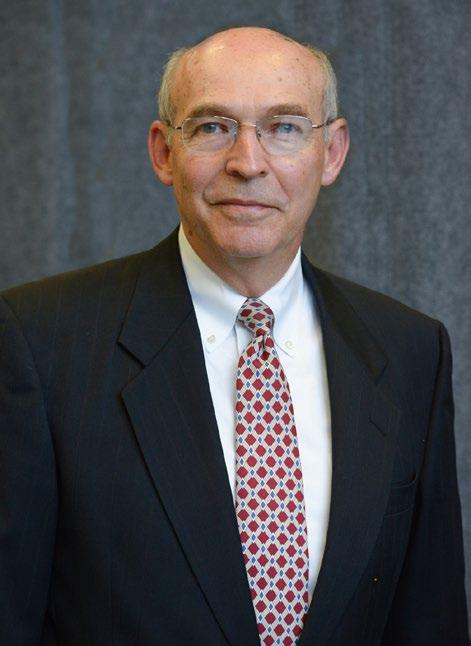
Illinois Tech alumna and Life Trustee Anita M. Nagler (LAW ’80) realized that she had a profound interest in social causes, education, and philanthropy early on in her educational career. That profound interest turned passion inspired Nagler to pursue her legal education at Chicago-Kent College of Law, and eventually—with her first $50 donation to the Chicago-Kent Alumni Fund in 1986—kickstarted her philanthropic journey at Illinois Tech.
Nagler graduated with her bachelor’s degree in social work from the University of Illinois at Urbana-Champaign, and, while working at a public defender’s office during her final undergraduate semester, she realized that she could achieve more as an attorney working in public interest than she might at the one-on-one social work level. With a renewed sense of purpose, Nagler enrolled in Chicago-Kent in 1977.
After law school, Nagler worked for the United States Securities and Exchange Commission for 13 years, eventually rising to run the enforcement program in its Midwest Regional Office. Thereafter, she joined Harris Associates, a Chicago-based investment firm, where she was a partner and chief operating officer; she later became CEO of Harris Alternatives, LLC, an alternative investment firm spun out of Harris Associates. Nagler retired from Harris Alternatives at the end of 2005.

It was during her tenure on Illinois Tech’s Board of Trustees that Nagler came to learn about The Chicago Difference, a community transformation and scholarship initiative—one that marries her passion for social good and education—that is designed to provide support for talented young people from underrepresented backgrounds in Chicago across their entire student journey, from pre-college to career placement assistance.
“The Chicago Difference is a meaningful long-term initia-
tive that is not just another scholarship born out of traditional models,” says Nagler. “Most collegiate support comes in the form of traditional scholarships, and, while there is a place for this type of support, it is very limiting in reality.”
For Nagler and her husband, Robert Moyer, what really resonated was the program’s pre-college emphasis, as they believe that in order for initiatives such as The Chicago Difference to be truly impactful they must provide support in a more holistic fashion—and go back further than simply giving scholarship funds upon entry. Nagler explains that this type of collegiate support is often designed to assist and provide opportunities to young adults in highly challenged neighborhoods and overlooks one very important reality: they simply do not have the background to get into college in the first place—or if they do get in, they lack the necessary skill set to succeed or even stay in.
“And they’re unlikely to get it the summer before they start school,” Nagler adds. “In some cases, these kids may not even make it to senior year of high school.”
For this reason, Nagler has earmarked her $1 million pledge to The Chicago Difference specifically to be utilized by applicants between their sophomore and junior year of high school in the hope that they can have a proper chance at success before stepping foot onto campus.
“My husband and I like to see talented, underprivileged kids with initiative be given every opportunity to learn a good skill, be well employed, and have the chance to uplift themselves and their families to higher income brackets,” she says.
In recognition of her unwavering support of Illinois Tech, Nagler and her husband will join the ranks of other philanthropic families in the Philip Danforth Armour Society— named in honor of the university’s founding donor.
—Howard J. LeeJoseph “Joe” Hakes
Former Illinois Tech Athletics
Director Joseph “Joe” Hakes, who led the athletics department from 2014 until 2020, passed away on Monday, January 23, 2023, at his home in Bristow, Virginia. During his tenure at Illinois Tech, which started in August 2014, Hakes oversaw the school’s transition from a National Association of Intercollegiate Athletics (NAIA) member school to a National Collegiate Athletic Association (NCAA) Division III member school; he also secured the school’s membership into the Northern Athletics Collegiate Conference (NACC). Hakes expanded the athletics program by adding men’s volleyball, men’s lacrosse, women’s tennis, and men’s tennis, the last of which became the first Illinois Tech program to qualify for an NCAA Division III tournament in 2019.

Dimitri Gidaspow (GT ’62) Distinguished Professor Emeritus
Dimitri Gidaspow (Ph.D. GT ’62), a prolific and innovative chemical engineering researcher and teacher, passed away on January 9, 2023, at the age of 88. Gidaspow’s contribution to the research and education of fluidization and fluid particle systems was extraordinary, and his work has had a huge impact in shortening the gap between lab-scale research and commercial processes. Over the course of his career, he received 10 patents, wrote four books and more than 200 publications, and had close to 20,000 citations.
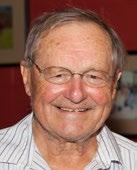
Peter H. Greene
Professor Emeritus of Computer Science
Peter H. Greene passed away on January 29, 2023. Trained as a mathematical biologist, Greene took an interest in understanding how organisms control their actions, which led him to mathematical models of brain function in the late 1950s, and later, the nascent field of artificial intelligence. His first paper on AI was published in 1959; in 1974, Greene joined Illinois Tech to begin the Department of Computer Science’s program in AI. He retired and was bestowed emeritus status in 2003.
Vivien Gross Clinical Professor of Law Vivien

Gross, an expert on legal professional ethics who guided Chicago-Kent College of Law’s two major clinical externship programs, passed away on March 4, 2023. The programs are a strength for Chicago-Kent, where they place students with federal and state court judges and offer them fieldwork in the private and public sector. Gross was also the professor-reporter for the Illinois Supreme Court Committee on Professional Responsibility, which reviews the entire body of rules and professional responsibility issues that affect Illinois lawyers. She joined the Chicago-Kent faculty in 1979, and was known as a welcoming and supportive colleague.

Seok Hoon Hong
Associate Professor Seok Hoon Hong passed away on February 18, 2023. Hong joined Illinois Tech’s Department of Chemical and Biological Engineering in 2015. He was a highly awarded scientist who had recently received a number of prestigious research honors, including Illinois Tech’s 2020 Sigma Xi Excellence in Research Award and the 2020 President Young Investigator Award from the Korean Institute of Chemical Engineers. Additionally, in 2022, Hong was recognized by the dean of Armour College of Engineering with the Excellence in Research Award.

Harvey Kahalas
Former Stuart School of Business Dean Harvey Kahalas passed away on February 4, 2023, at age 81. During his tenure at Stuart, Kahalas successfully led the Association to Advance Collegiate Schools of Business re-accreditation process; hired many outstanding faculty; and revised and updated many of Stuart’s programs, in addition to creating multiple new cross-disciplinary and multidisciplinary programs. He also developed initiatives to facilitate English language knowledge and proficiency for international students, and implemented an internship program designed to create an understanding of American business processes. In retirement, Kahalas continued to engage with Stuart as a professor emeritus of management and economic development.
Joe HakesArthur S. Takeuchi (ARCH ’54, M.S. ’59)
Arthur S. Takeuchi, a pupil of Ludwig Mies van der Rohe and a College of Architecture faculty member who was the chief assistant architect of the Richard J. Daley Center, died on October 28, 2022, at age 91. He joined the Illinois Tech faculty in 1965 and opened his own architectural firm in 1970. Takeuchi was the recipient of numerous teaching awards during his time with the College of Architecture, where he served twice as interim dean and taught for 54 years before his retirement in 2019.
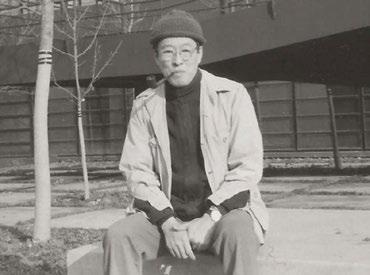
Jerome R. Vainisi (LAW ’69)
Jerome “Jerry” Vainisi, the general manager of the Super Bowl XX champion Chicago Bears, died on October 4, 2022, at the age of 80. Vainisi spent 15 years with the Bears, serving in various financial and legal roles until Bears owner George Halas appointed him general manager in 1983. During his four years as GM, Vainisi helped lead the Bears to an overall record of 47–17; he later became head of player personnel for the Detroit Lions, where he drafted Barry Sanders, and was also the co-founder and head of football operations for the World League of American Football/NFL Europe. Since 1999 Vainisi had been owner and chairman/CEO of Forest Park Bank in Forest Park, Illinois.
Maurice “Jerry” Frank Jr. (MATH M.S. ’69, Ph.D. ’72)
Professor Emeritus of Applied Mathematics
Maurice “Jerry” Frank Jr. passed away on February 13, 2023. Frank joined the applied mathematics faculty at Illinois Tech in 1976 and continued his teaching and research career until 2008, when he achieved emeritus status. Additionally, he helped to establish Illinois Tech’s annual Karl Menger Lecture and Awards program. He was an expert in numerous subjects, including functional equations, associativity and related equations, iterative equations and systems, probability distribution theory, probabilistic geometry, and nonlinear dynamics. He spoke on these topics internationally, and was department chair for a time.
Alumni
Harold L. Cohen (DSGN ’49)
Seymour V. Parter (MATH ’49, M.S. ’51)
Fred P. Boulais (IE ’50)
Milton E. Cox (EE ’51)
Edward V. Mochel (CE ’51, M.S. EGC ’57)
Wayne Nestander (CE ’51, M.S. BENG ’53)
Robert Babbin (ARCH ’52)
Sanford M. Hanberg (EE ’52)
Roger L. Triemstra (ME ’52, M.S. EMGT ’59)
David O. Campbell (Ph.D. CHEM ’53)
William O. Park II (FPSE ’53, M.S. BENG ’61)
John H. Schruben (M.S. CE ’53)
Richard B. Spector (MET ’53)
Vincent F. Bobrowicz (EE ’54, M.S.’55)
Arthur L. Rozema (ME ’54)
Arthur S. Takeuchi (ARCH ’54, M.S. ’59)
Max D. Epstein (M.S. EE ’55, Ph.D. ’64)
Arthur Manaster (ME ’57)
John Albert Shell (CE ’58)
Stuart Henry Moss (BE ’59)
David W. Ferriday (ARCH ’60)
James R. DeStefano (ARCH ’61)
Robert Leslie Herting (M.S. BCHM ’61, Ph.D. BIOL ’70)
Robert C. Zimmerman (DSGN ’61)
Dimitri Gidaspow (GT ’62)
Walter J. Meder Jr. (EE ’62)
Robert B. Stevens (FPSE ’63)
Prem L. Ajwani (M.S. ME ’64)
James H. Clemmons (EE ’64)
Charles E. Gregersen (ARCH ’66)
Harold E. Nelson Jr. (EE ’66)
John R. Vergoth (M.S. MED ’66)
Michael J. Grogan (Ph.D. CHEM ’67)
Frederick E. Juliano (M.S. ENVE ’67)
Ronald L. Bonnevier (IE ’68, M.A.E. ’69)
Paul Ebner Gartz (EE ’69)
Jerome R. Vainisi (LAW ’69)
Ronald G. Ginani (EE ’70)
Jerry A. Kotulla (EE ’70, M.S. ’71)
Richard P. Curtin (LAW ’71)
Dennis W. Lamont (EE ’72)
Albert F. Schulien Jr. (MAE ’72)
Lester C. Torrey (EE ’73)
Charlotte P. Trolinger (ARCH ’73, M.S. DSGN ’78)
Lillian S. Gilruth (M.S. DSGN ’74)
Robert R. Lindstrom (ECO ’74)
Richard C. Adamczewski (M.S. IE ’75)
Leonard L. Koplitz (M.A.S. PA ’76)
Robert W. Boness (EE ’77)
Joseph B. Fitzpatrick (M.A.S. BA ’78)
Garvin B. Nix (M.A.S. PA ’79)
William V. Lipton (M.A.S. BA ’80)
Thomas L. Lockhart (LAW ’80)
Revelle G. Peritz (LAW ’80)
Carlos G. Rizowy (LAW ’83)
Peter F. Herzog (LAW ’85)
Mary A. Jachna (LAW ’89)
Daniel J. Houle (EE ’91)
Geraldine B. Berger (LAW ’92)
Michael Munoz (AE ’92)
Jordan R. Labkon (LAW ’95)
R. Scott Terdic (EE ’98, MBA ’06)
Andre Toguem (Ph.D. CS ’01)
Jon M. Ellison (LAW ’12)
Westley A. Villalobos (AE ’13, ME ’13)
Faculty
William D. Palm
Joyce B. Van Cura
Friends
Marguerite A. Hark (nee Delany)
Gene K. Edlin
Dorothy D. Hawley
Pamela Kelley Hull
Kennetha “Posy” Krehbiel
James L. Nagle
William A. Pogue
Henry Rasof
Joanne C. (Repicky) Smith
Howard J. Trienens
Non Graduate Alumni
JoAnne Courtney
Mary Owen (nee Wrenn)
Arlen Moller is an associate professor of psychology at Illinois Tech. His primary research interest involves promoting healthy lifestyle changes that last. He and Illinois Tech Associate Professor of Psychology Nicole “Nikki” Legate recently completed a study that tested different communication strategies for encouraging people to socially distance during the worst months of the COVID-19 pandemic.
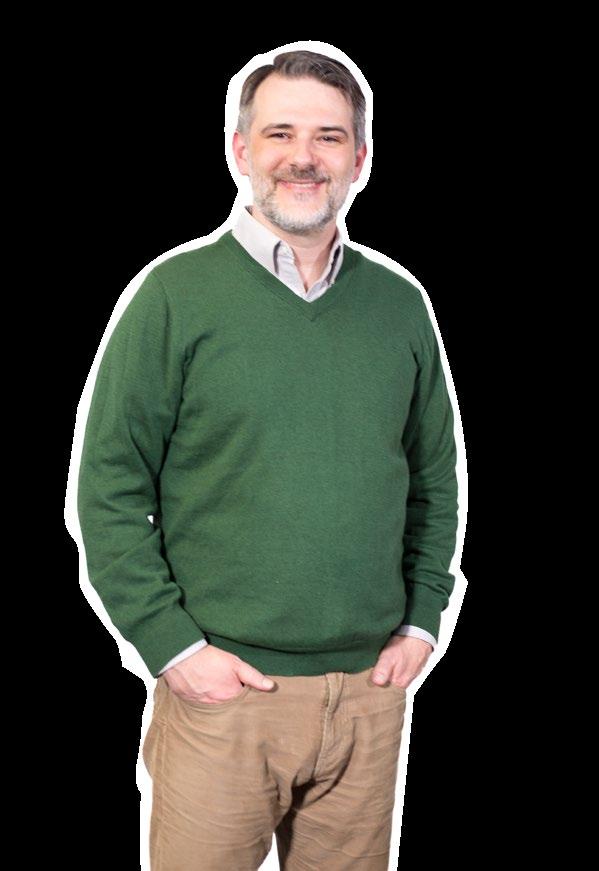
Your study notes that controlling messaging—messages that were authoritarian— increased “controlled motivation,” which is a “poorly internalized form of motivation.” Could you explain why?
A: It helps to contrast the idea of autonomous motivation with controlled motivation. Autonomous motivation involves feeling like you fully and freely endorse what you’re doing, and is considered well internalized. The alternative, controlled motivation, involves feeling pressured or coerced. Controlled motivation is considered poorly internalized in the sense that we can be motivated (sometimes strongly) without fully and freely endorsing what we’re doing.
Can you give an example of “autonomy supportive” messaging that you thought was particularly effective?
A: Messaging that communicates empathy and respect. When spoken, this messaging can include tone of voice, pitch, and more. Words matter, too. For example, the words used for a controlling message might be: “you must wear a mask,” with the speaker leaning into “must.” To contrast styles, the words used for an autonomy-supportive message might be: “you might choose to wear a mask, and here are the reasons why.”
You note in the same study that none of the messages about social distancing influenced a person’s “autonomous motivation,” and this surprised you. Why?
A: In hindsight, one factor that we didn’t adequately account for is that the participants in our study were exposed to lots of different messages encouraging social distanc ing during the early months of the pandemic. So, their motivations to socially distance were being influenced not just by the messages we showed them, but also by thousands of other messages.
You’re currently interested in the psychology of “defiant backlash.” In the case of social distancing, “defiant backlash” resulted in fewer long-term behavioral intentions to socially distance in the future. Why did this happen?
A: Defiant backlash is an emotional, often irrational, way of reasserting control when people feel their autonomy is threatened. It involves doing the opposite of what was asked for. Ironically, doing the opposite of what’s been asked is often self-defeating, and something a person doesn’t really endorse in a meaningful way. Because this reaction is emotional rather than rational, when people reflect on it later, they often regret how they behaved. Ultimately, I’m not pro or anti disobediance to authority—both can be good or bad—more important is whether people really
Are there any lasting effects of “defiant backlash”? Does the use of controlled or autonomous motivation affect how people view the messaging agencies themselves over the long term?
In the big picture, a lot of studies find that lives characterized by more controlled motivation (less autonomous motivation) are lives that tend to be less happy, healthy, and satisfying. By the same token, when people go through life regularly allowing themselves to be reflexively defiant for the sake of being defiant, that’s typically not a good recipe for health or happiness. In terms of public safety, to the extent that controlling communication styles used by government officials may have exacerbated defiant backlash to COVID-19-specific policies, the long-term concern is that this could extend to other public
Students from four Chicago-area high schools—including Homewood-Flossmoor Community High School, Lane Tech College Prep High School, Baker College Prep, and Dunbar Vocational Career Academy—participated in Armour College of Engineering Day in March 2023. Here, two high school students take part in an activity during the Elevate College Prep event.
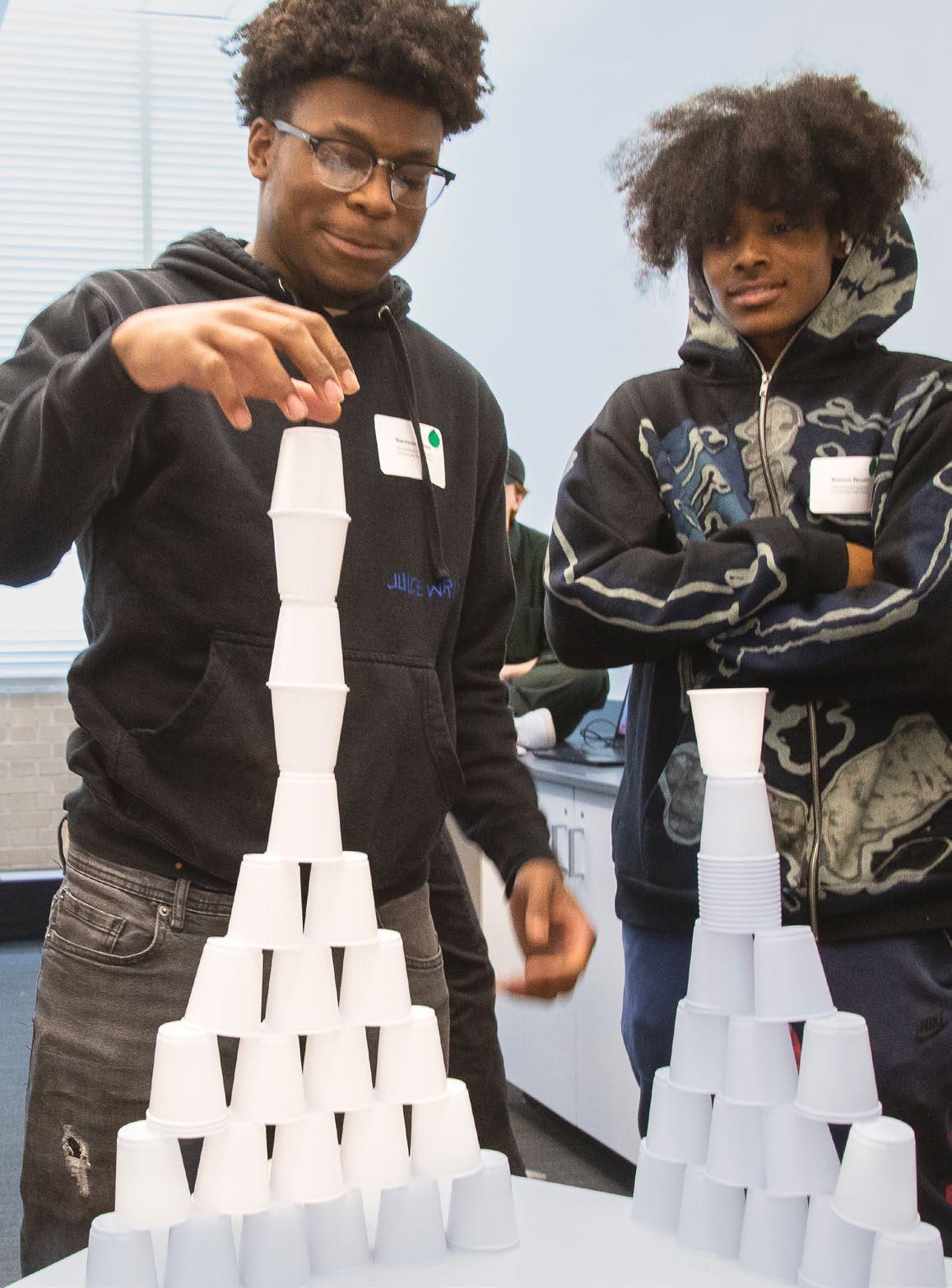 Photo by Jamie Ceaser
Photo by Jamie Ceaser
